The USCGC Eagle, known as “America’s Tall Ship,” is the largest sailing vessel flying the Stars and Stripes and the only active square-rigger in U.S. government service1.
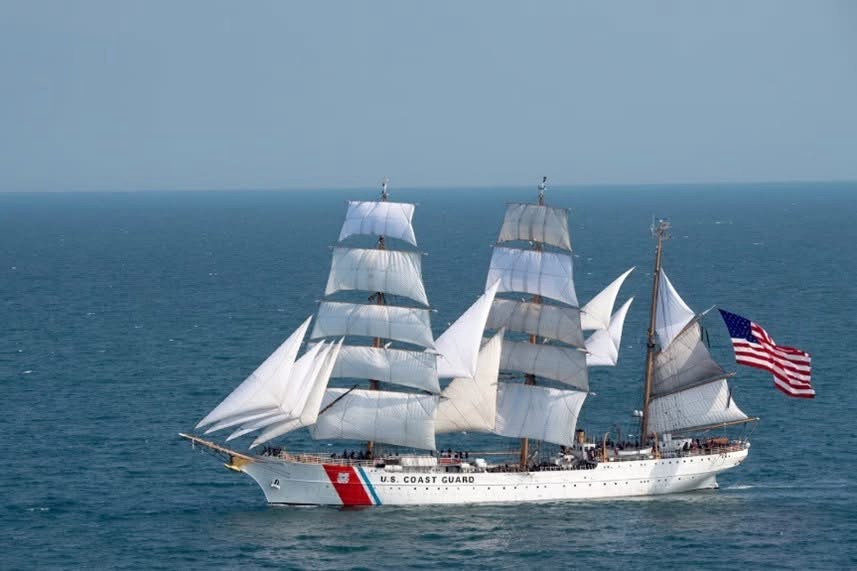
USCGC Eagle is visiting Seattle in July 2025 as part of her West Coast summer training cruise, and her visit is tied to Seafair which officially started on June 20.
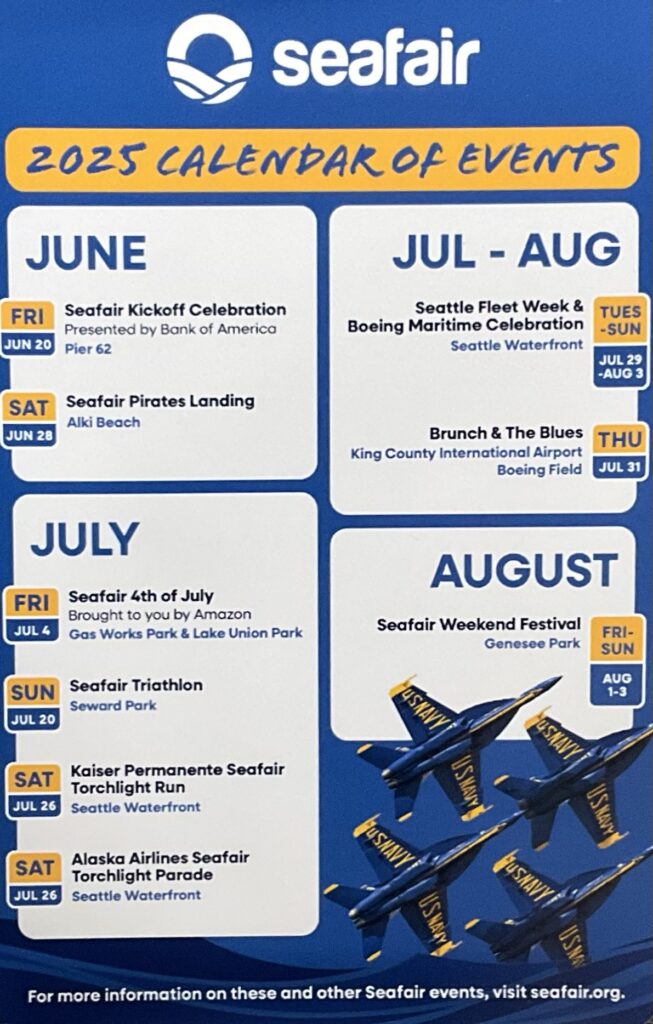
Eagle is scheduled to be in Seattle on Wednesday July 9 2025125 and Thursday July 10 (Pier 66). 3,000 are expected to visit. Seafair Weekend Festival, Seattle’s major boating and air show event, takes place August 1–3, 20254, after Eagle’s scheduled Seattle port visit and Seafair swag is to be distributed on the vessel. The Eagle hasn’t visited the West Coast of the USA since 2008 (17 years ago)
Eagle will visit Victoria, Canada, after departing Seattle in 2025125.
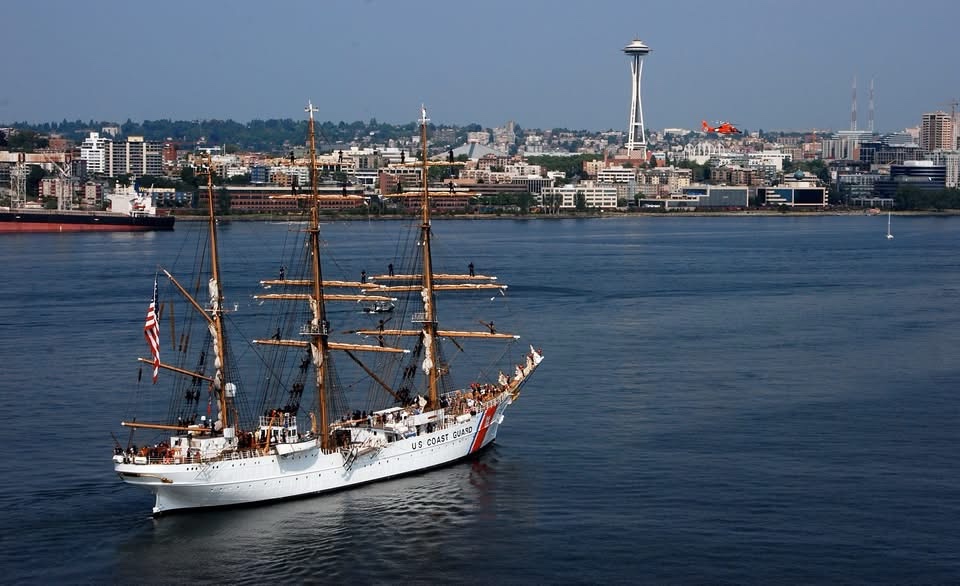
In short: Eagle is visiting Seattle in July, as part of Seafair but not during the weekend when the Blue Angels fly and she will also visit Canada (Victoria) later that month125.
This magnificent barque has a rich and fascinating history that spans nearly nine decades.
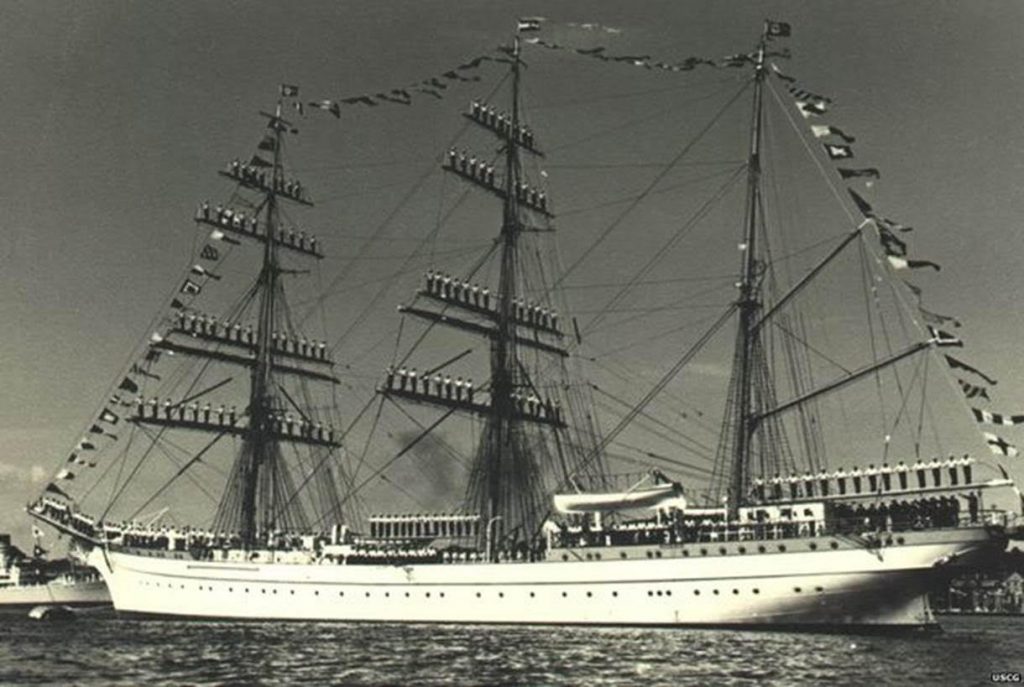
Historical Origins
The Eagle was built in 1936 at the Blohm+Voss Shipyard in Hamburg, Germany, and originally commissioned as the Horst Wessel12. She was one of three identical sail-training ships operated by the pre-World War II German navy to train cadets for naval service2.
The ship was named Horst Wessel to honor Horst Wessel, a young member of the Nazi Party’s paramilitary wing, the Sturmabteilung (SA), who was elevated to martyr status by Nazi propaganda after his death in 193035. Wessel wrote the lyrics to the “Horst-Wessel-Lied,” which became the official anthem of the Nazi Party and, later, co-national anthem of Germany under Hitler25. He was 22 at the time of his death.
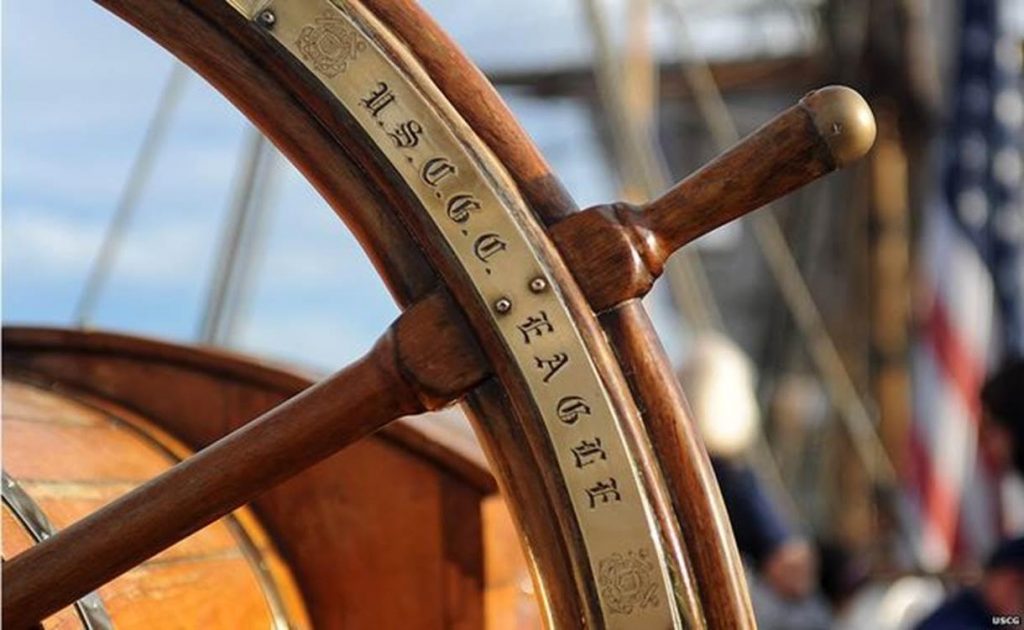
Naming Significance in Nazi Germany:
- The choice of “Horst Wessel” was unusual even for the Nazi era, as most German naval ships were traditionally named after historical naval heroes, not contemporary political figures13.
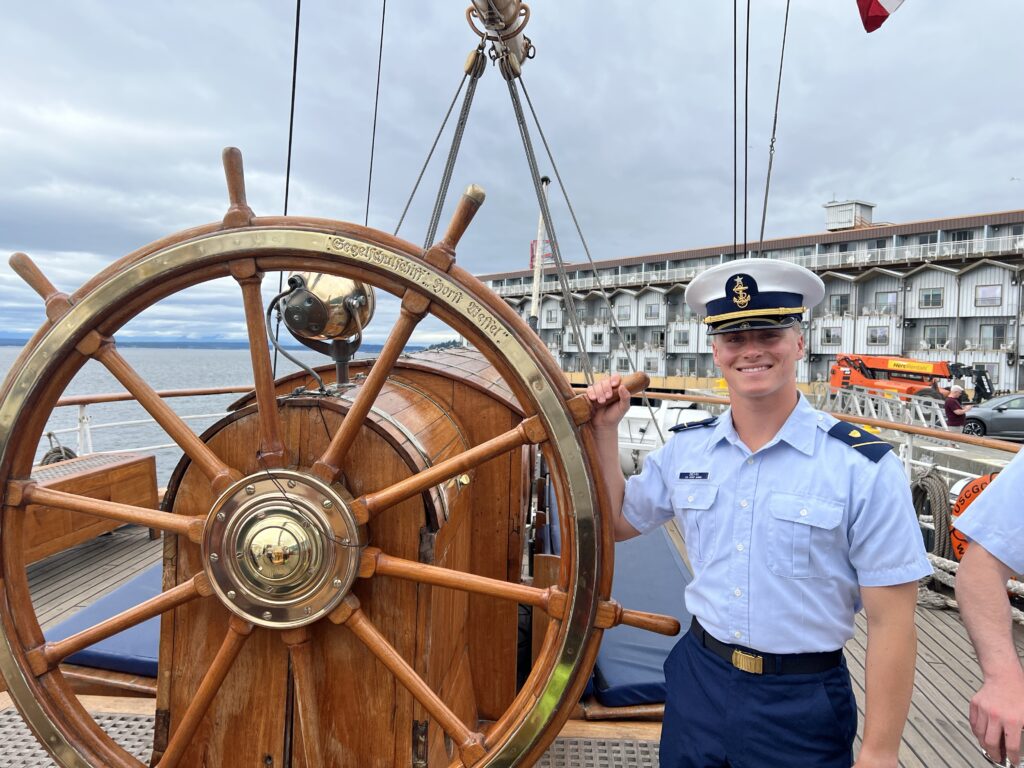
- The ship’s christening was a major propaganda event: Rudolf Hess gave the launch speech in the presence of Adolf Hitler, and Wessel’s mother christened the vessel1234.
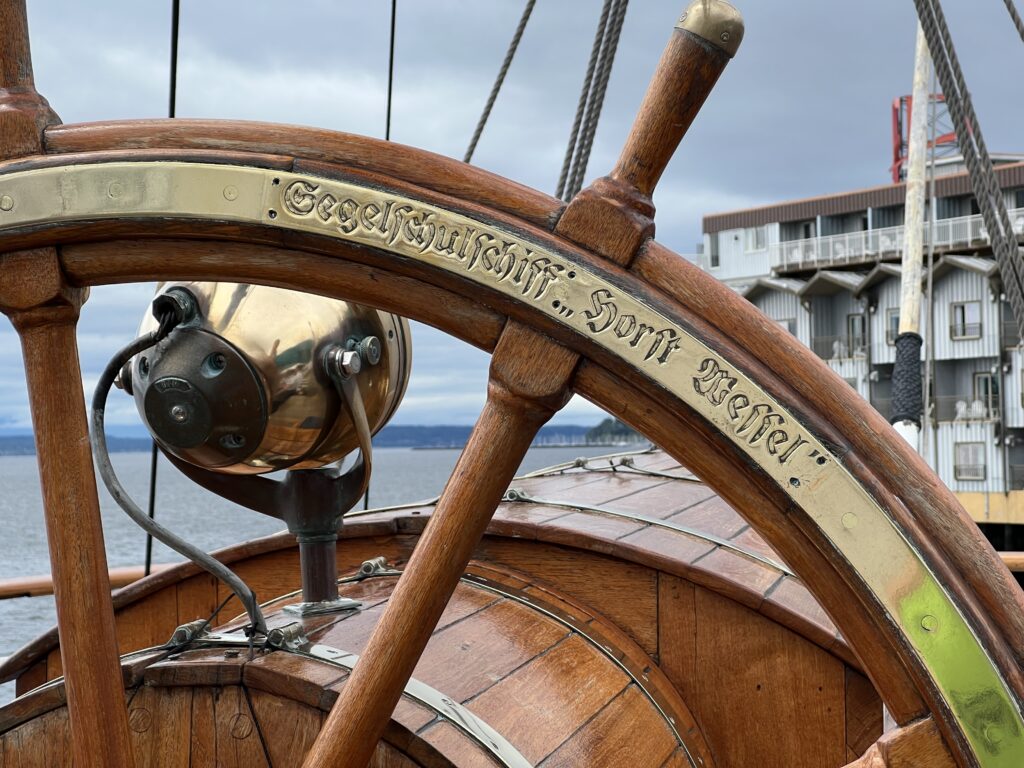
- At the ceremony, Hess declared, “This ship shall bear the name of the fighter and poet at the forefront of the German revolution,” directly linking the vessel to the Nazi movement’s ideological narrative14.
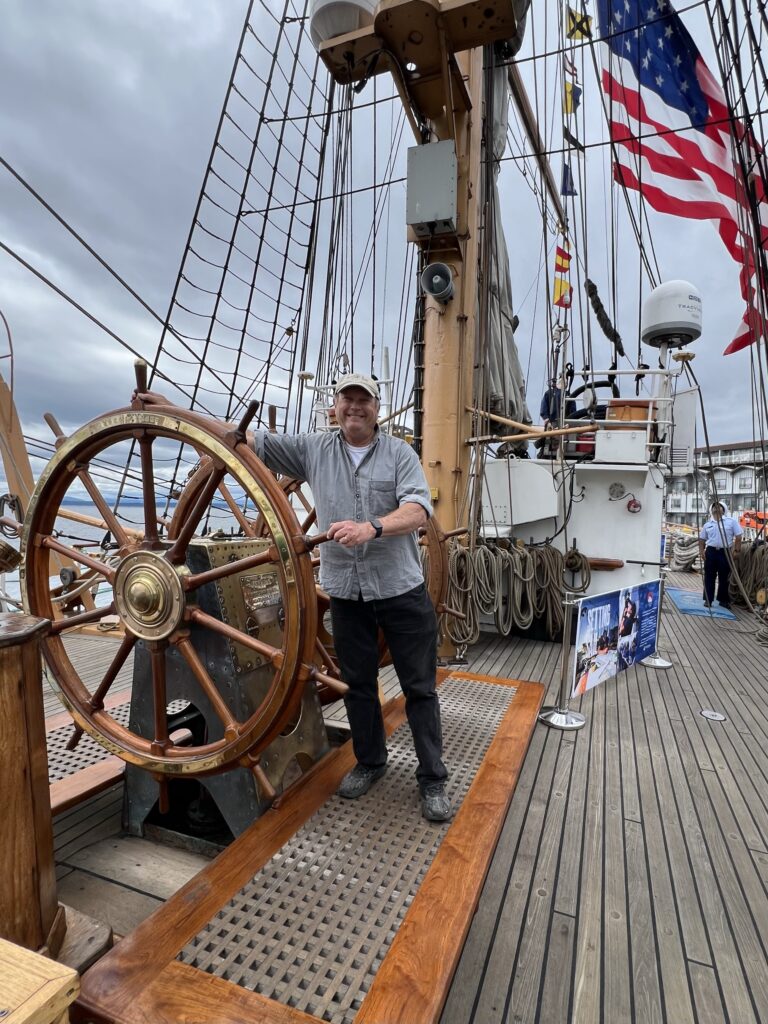
- Wessel’s story, though rooted in a violent and personal altercation, was recast by Nazi propaganda as a heroic sacrifice for the cause, making him a symbol of loyalty, self-sacrifice, and revolutionary zeal for the regime58.
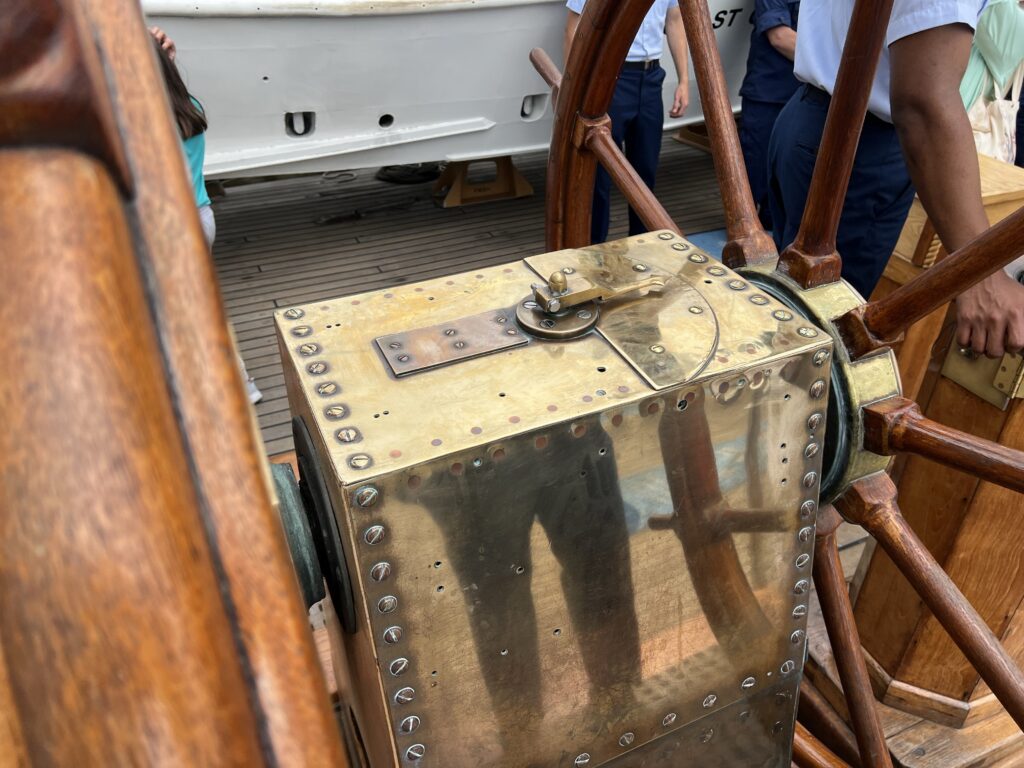
Symbolism:
- Naming the ship after Horst Wessel symbolized the Nazi regime’s desire to embed its ideology and propaganda into all aspects of German society, including the navy123.

- The ship became a floating tribute to Nazi martyrdom and served as a training ground for future naval officers indoctrinated with these ideals13.
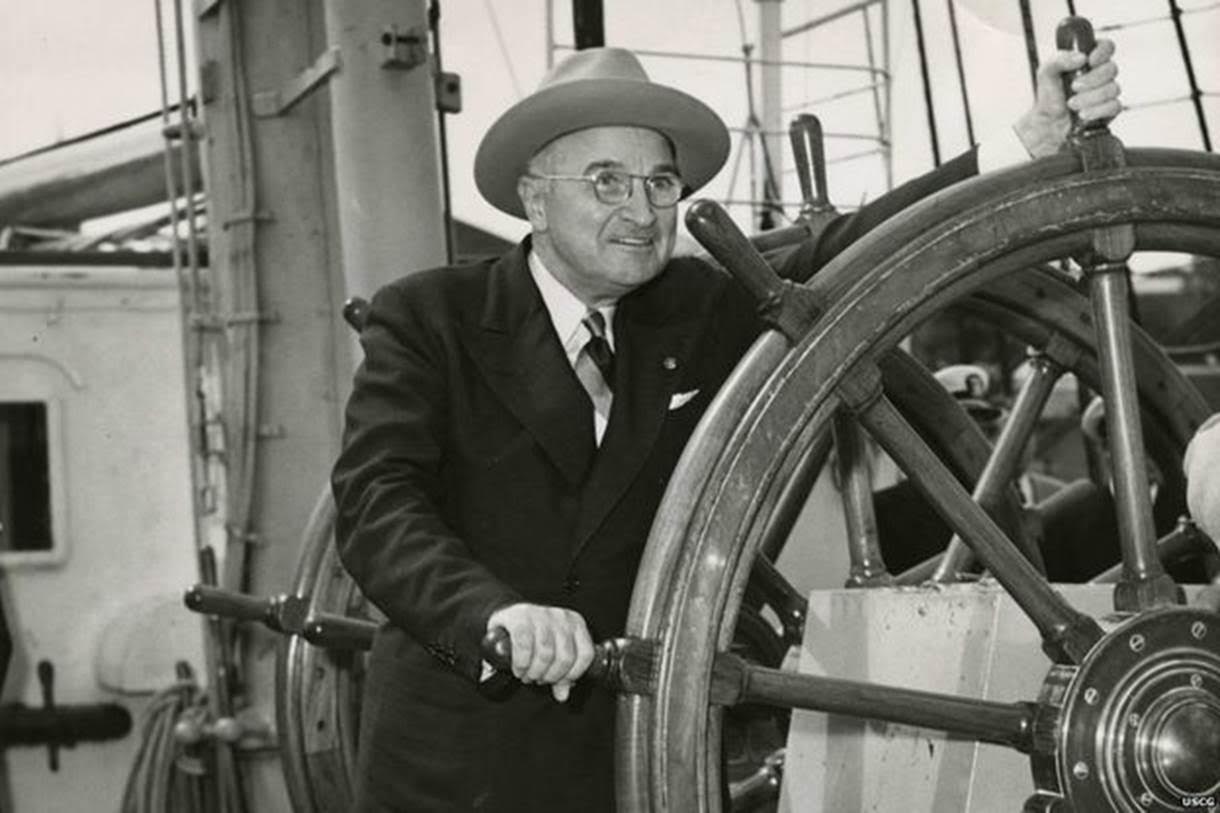
In summary, the name “Horst Wessel” was chosen to glorify a Nazi martyr and reinforce the regime’s values, making the ship a powerful symbol of Nazi propaganda and ideology.
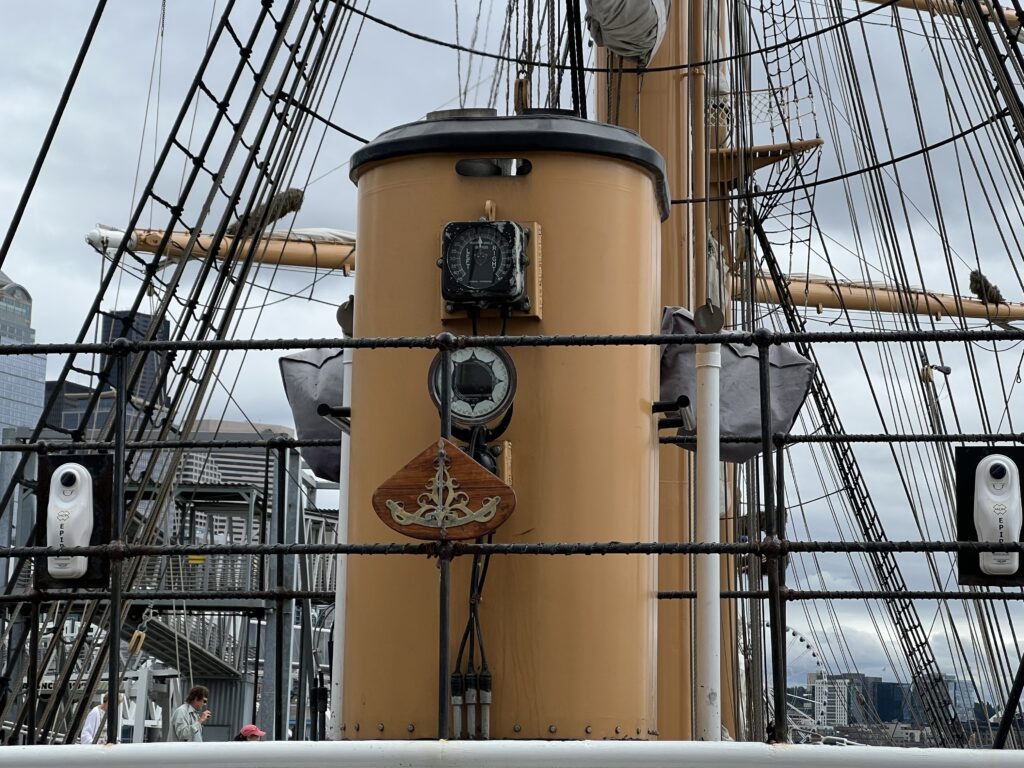
The vessel served the German navy until the start of World War II, when she was decommissioned from training duties3.
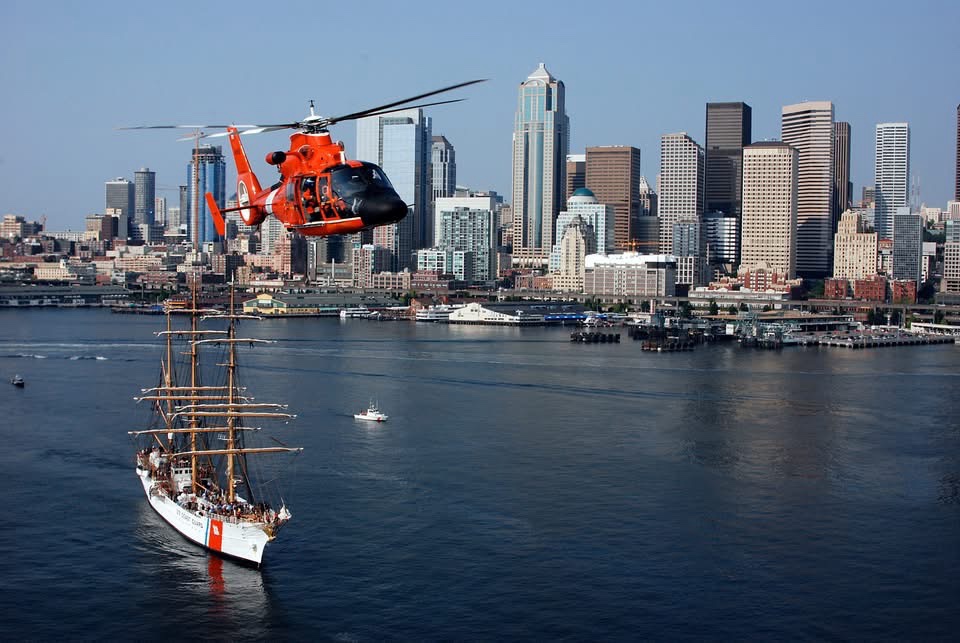
At the close of World War II, the ship became a war reparation for the United States41. In an interesting twist of fate, the allocation of captured German ships was determined by a lucky draw between American, British, and Russian commanders, with pieces of cardboard drawn from a cap3.
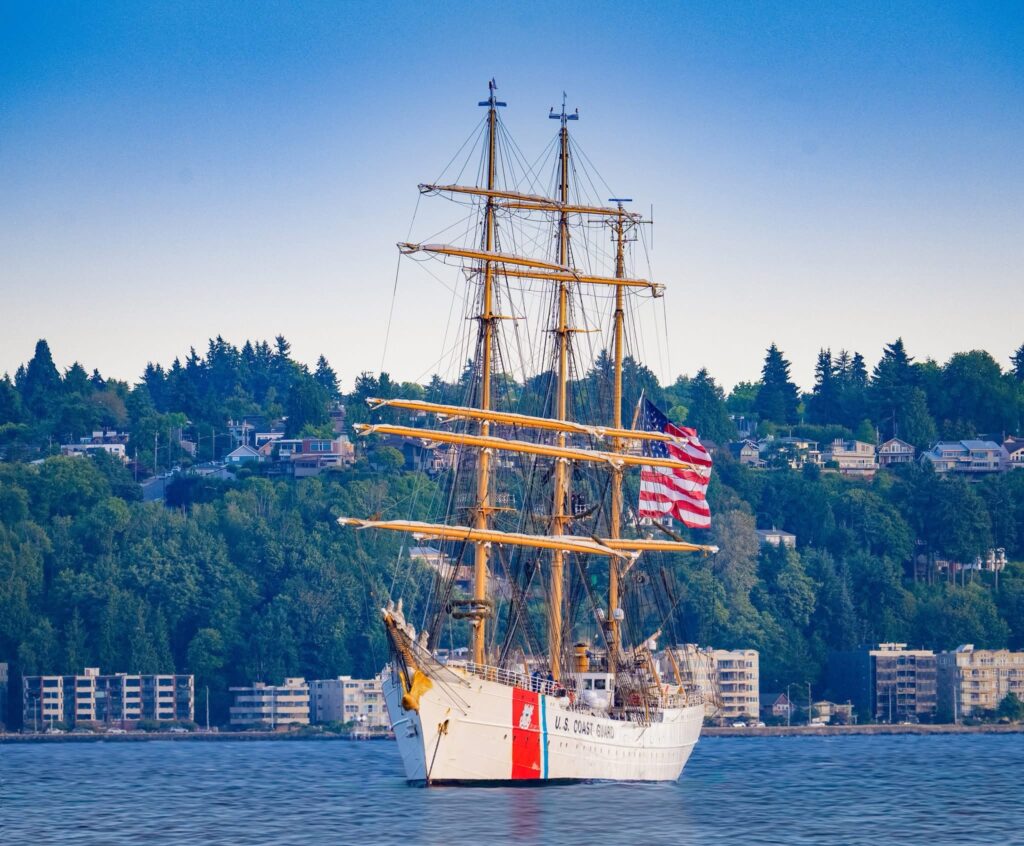
Though the Russian commodore initially drew the Horst Wessel, he secretly agreed to swap with the U.S. officer who was eager to bring the tall ship to America3.
In June 1946, an American crew, assisted by the original German captain and his remaining sailors, sailed the newly rechristened Eagle from Bremerhaven through an Atlantic hurricane to New York3. Since then, New London, Connecticut has been her permanent homeport near the U.S. Coast Guard Academy12.
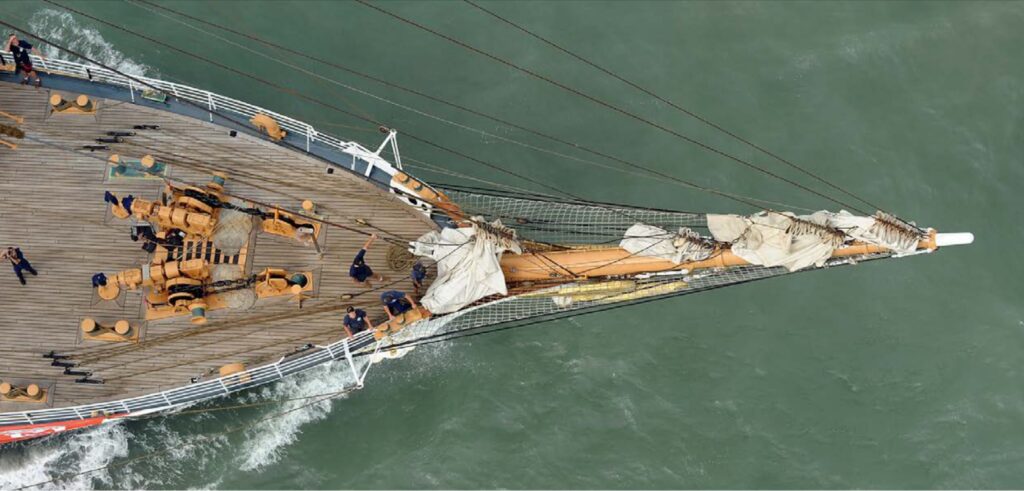
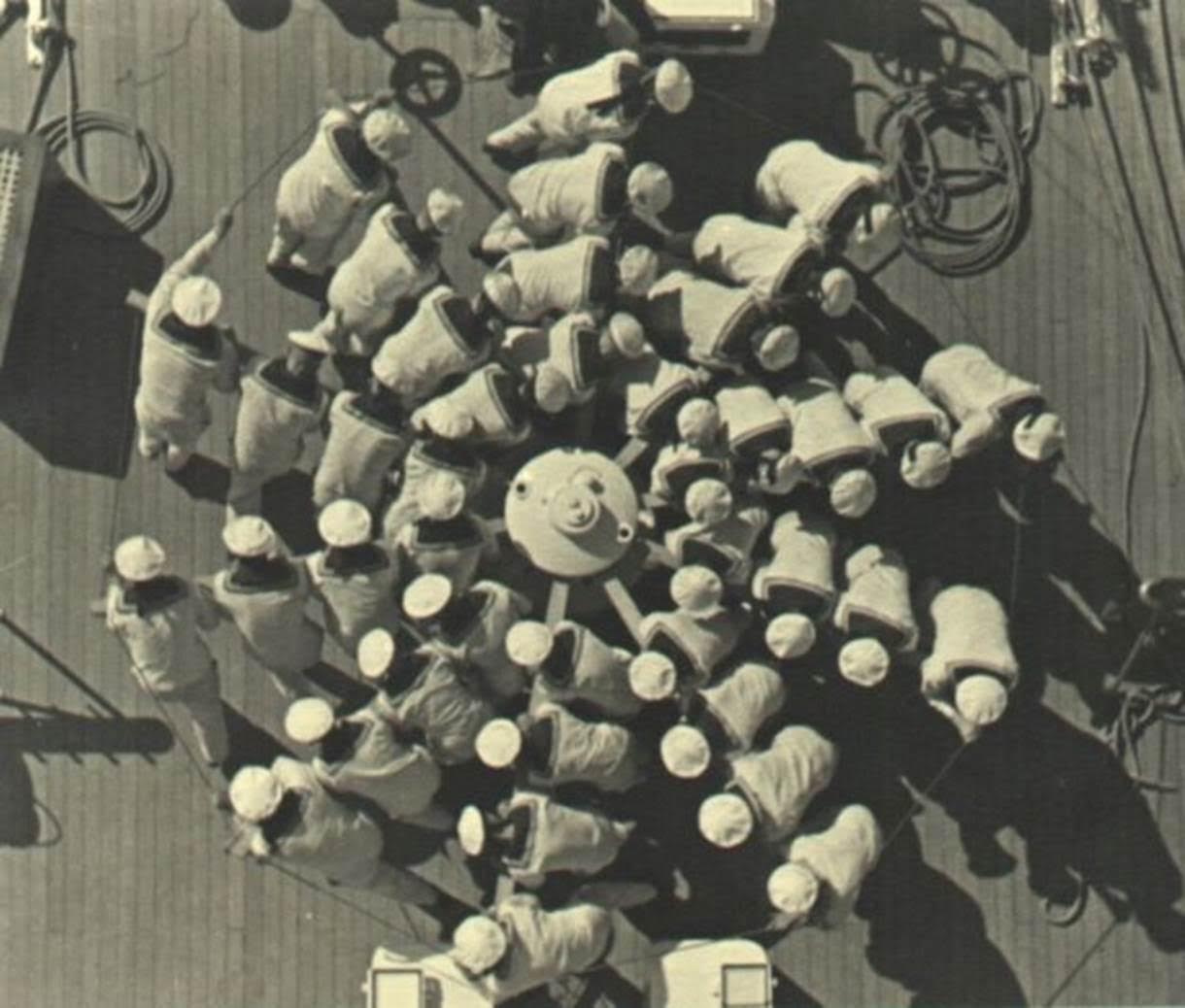
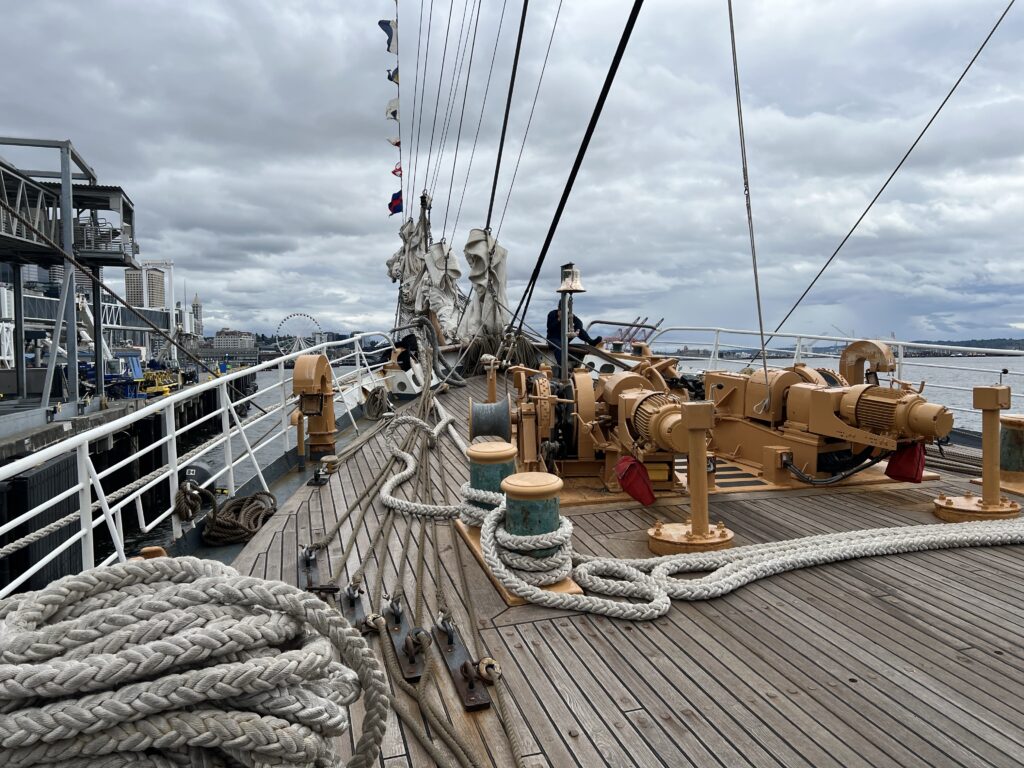
Sail Plan and Technical Specifications
The Eagle is classified as a three-masted barque, meaning she has square sails on the fore and main masts, while the mizzen (rear) mast is fore-and-aft rigged56. This specific sail configuration defines her as a barque-class vessel.
Sail Configuration Details

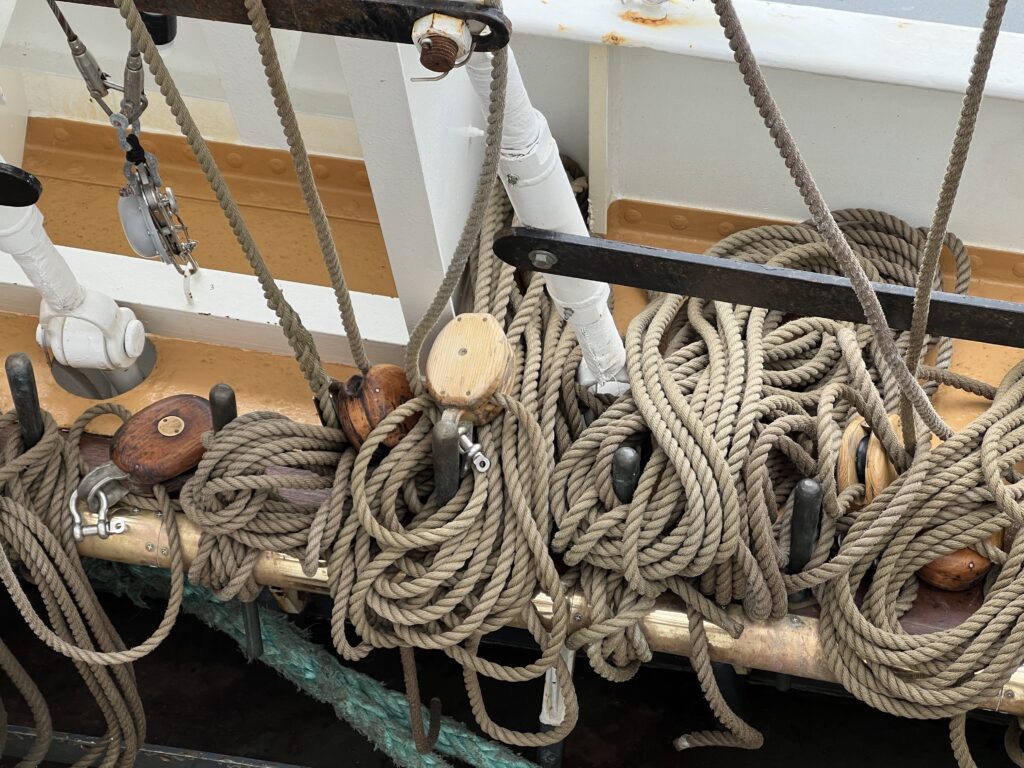
- Mast heights: The fore and main masts reach 147.3 feet above the waterline, while the mizzen mast stands 132 feet high7
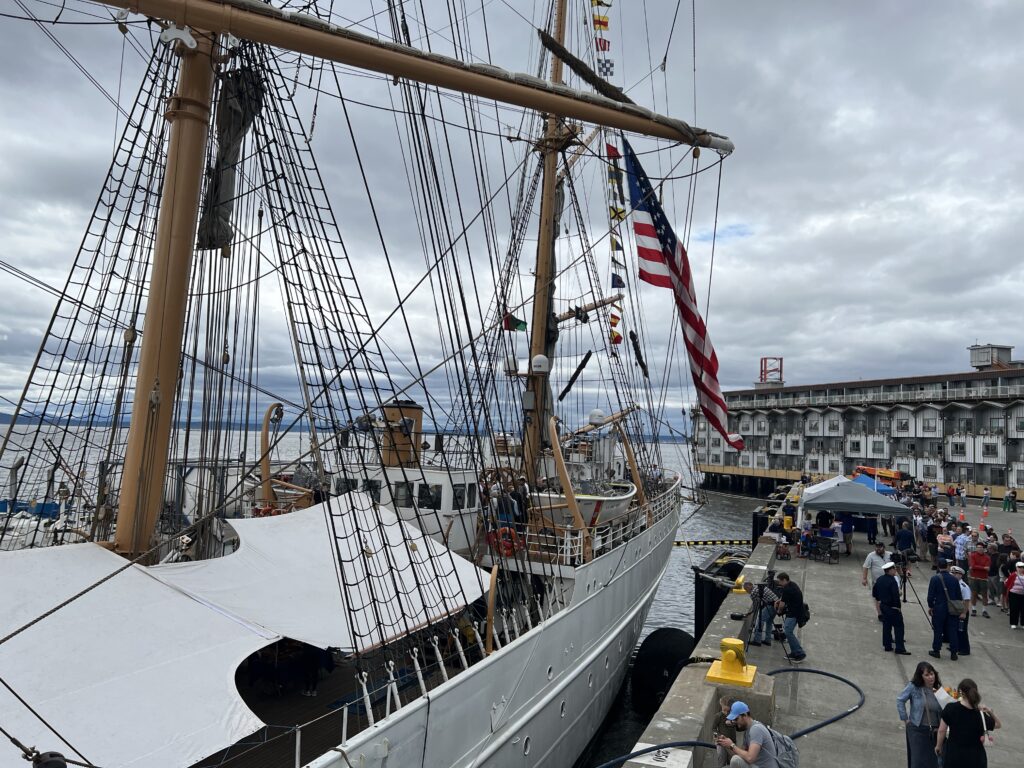

The fore and main masts carry square sails that allow the ship to achieve speeds up to 17.5 knots under full sail76. However, this square-rigged configuration limits the Eagle’s point of sail to around 70 degrees off the wind6. The mizzen mast features fore-and-aft rigged sails that provide better maneuverability.
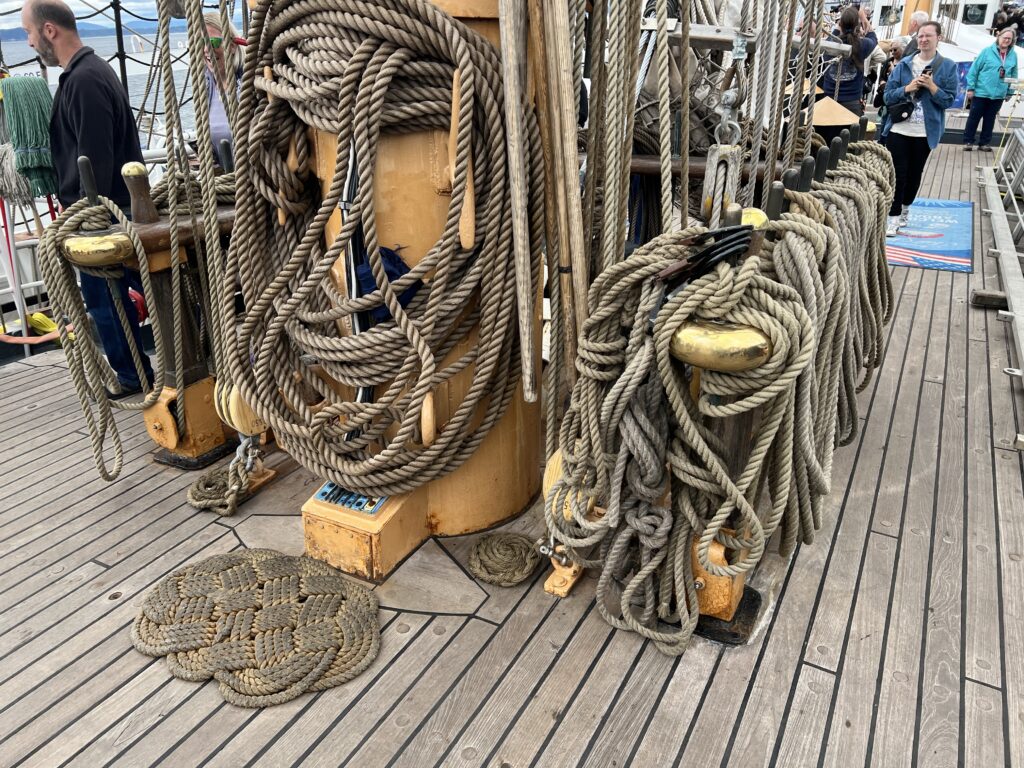
A fife rail is a horizontal rail—usually made of wood or iron—mounted around the base of a mast. It holds a series of belaying pins used to secure (belay) the running rigging, especially halyards and other lines associated with that mast. Fife rails are typically freestanding and may be horseshoe-shaped or straight, depending on the ship’s design. Each mast may have its own fife rail, named accordingly (e.g., main fife rail).
To operate the Eagle under sail, the crew must handle more than 200 lines that control the sails and yards2.
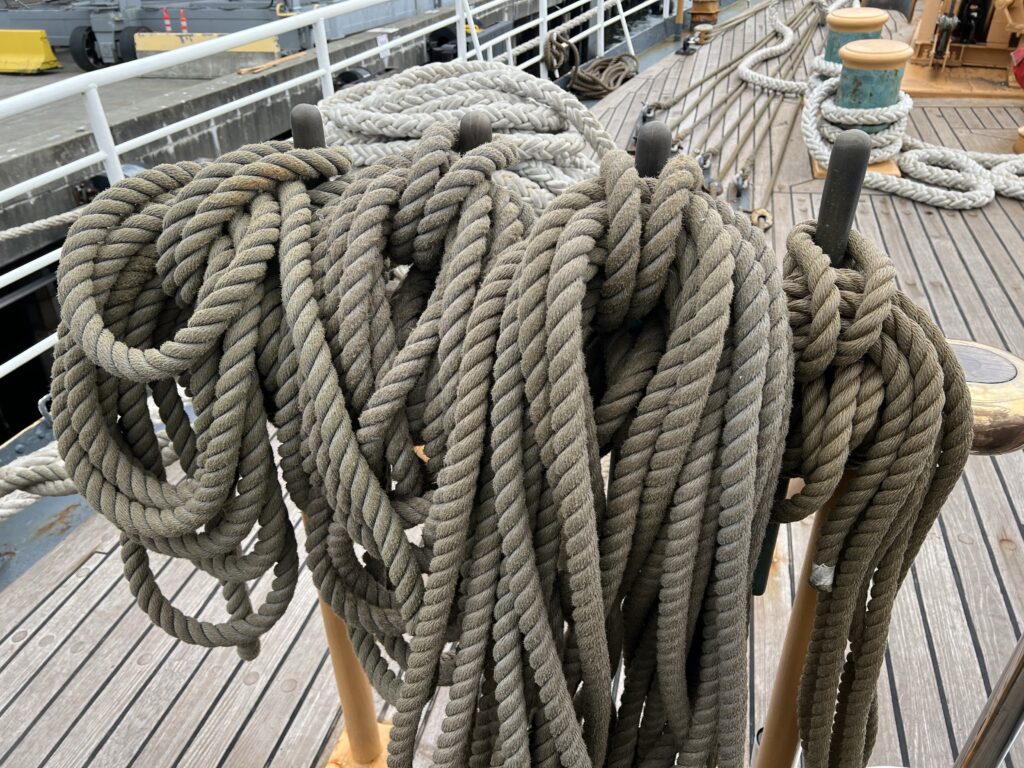
Every crew member, from cadets to officers, must become intimately familiar with the name, operation, and function of each line2.

Eagle’s ability to reach speeds of up to 17 knots under full sail is due to her three-masted barque sail plan, which maximizes both sail area and aerodynamic efficiency.
Key factors enabling high speed:
- Large Sail Area: Eagle carries 23 sails totaling over 22,000 square feet, spread across her three masts. The fore and main masts are square-rigged, providing substantial driving force when the wind is from behind or on the beam, while the mizzen mast is fore-and-aft rigged for maneuverability1246.
- Optimal Sail Angle: Her fastest point of sail is on a broad reach—when the wind is coming from behind and slightly to the side. In this configuration, the square sails catch the maximum amount of wind, propelling the ship efficiently. Eagle can maintain speeds of 17 knots, and has even been recorded at 19 knots under ideal conditions14567.
- Efficient Rigging: With six miles of running rigging, the crew can finely adjust the sails and yards to optimize the angle of attack and maximize lift from the wind, reducing drag and increasing speed12.
- Hull Design: Eagle’s long, steel hull and streamlined shape reduce water resistance, allowing her to convert wind power into forward motion more effectively124.
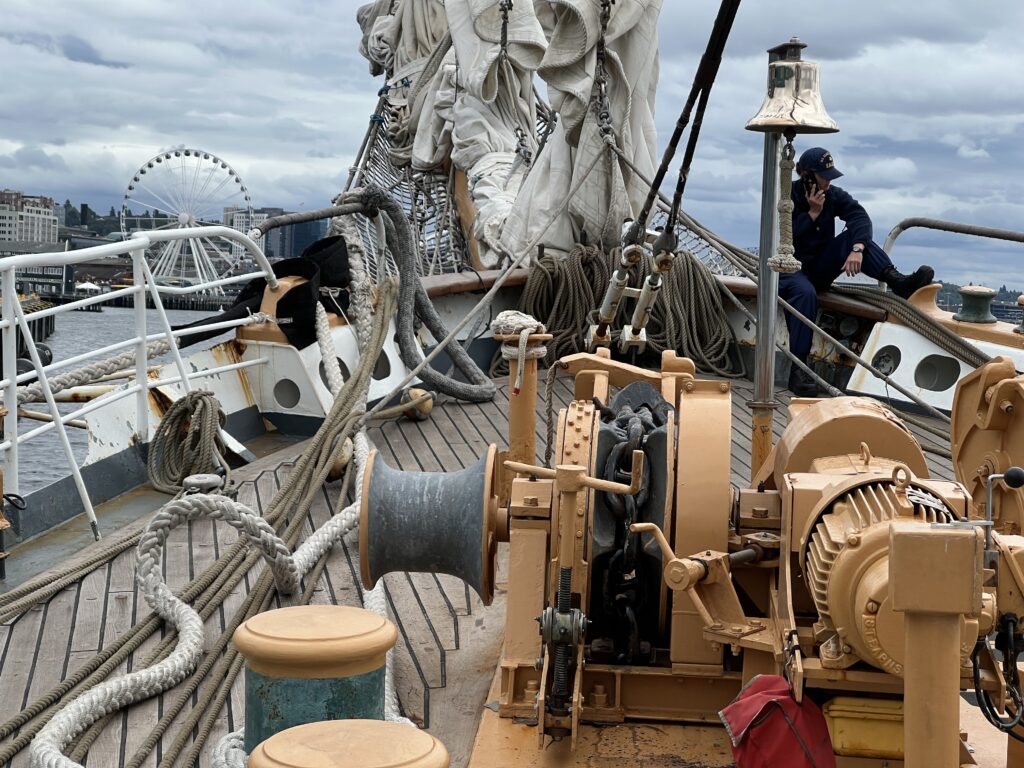
The term dog rail is less universally defined in classic sailing ship terminology. In some contexts, it refers to a low rail or barrier, often used to keep equipment or even small animals (like ship dogs) from sliding off deck areas, or as a secondary safety rail. On some vessels, it may also denote a low rail at the edge of a deck opening or companionway.
In summary, Eagle’s combination of a vast, well-managed sail area, efficient rigging, and optimized sailing angles enables her to reach and sustain high speeds under sail—a testament to classic tall ship design and skilled seamanship146.
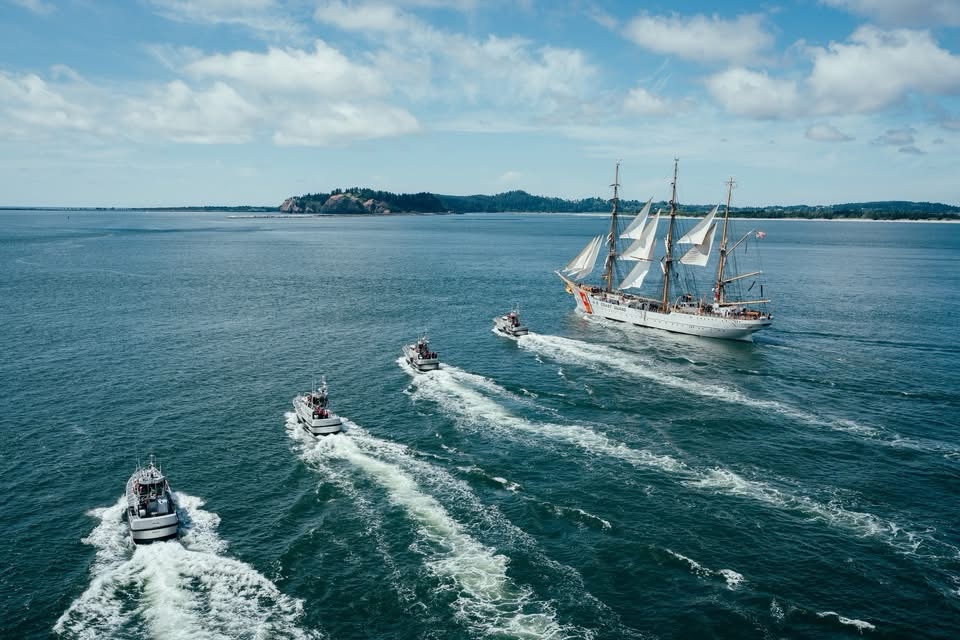
Ship Specifications and Design
The Eagle’s impressive dimensions reflect her role as both a training vessel and a seagoing ambassador:
- Length: 295 feet (90 meters) – roughly equivalent to a football field71
- Beam: 39.1 feet (11.9 meters)7
- Displacement: 1,816 tons (1,647.4 metric tons)7
- Draft: 17 feet when fully loaded7
- Hull construction: Steel, four-tenths of an inch thick with riveted construction32
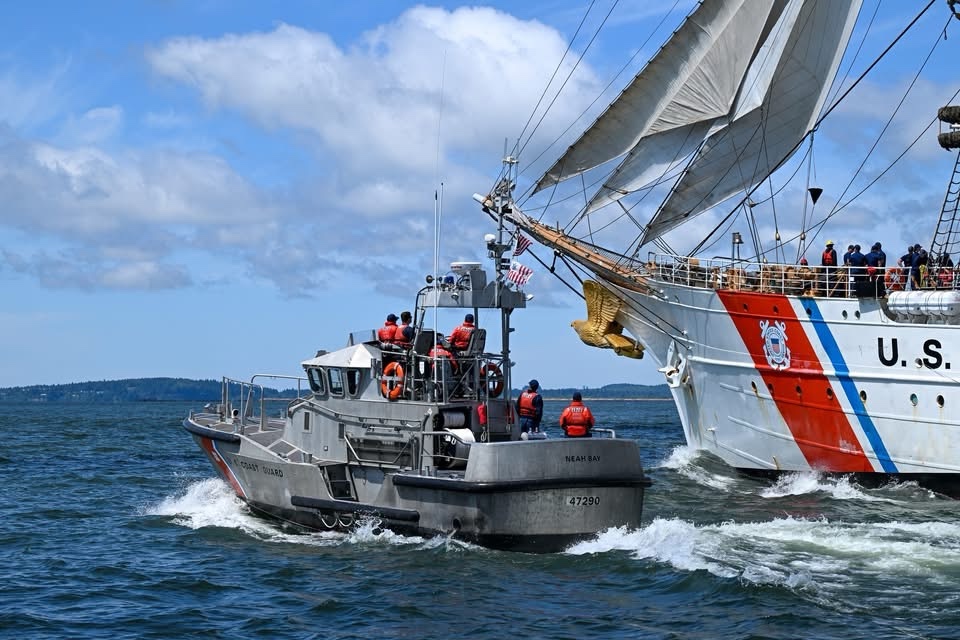
The raised forecastle and quarterdeck are made of quarter-inch steel overlaid with 3 inches of teak, as are the weather decks3. This combination of steel strength and traditional teak decking reflects the ship’s heritage from the twilight era of sail2.
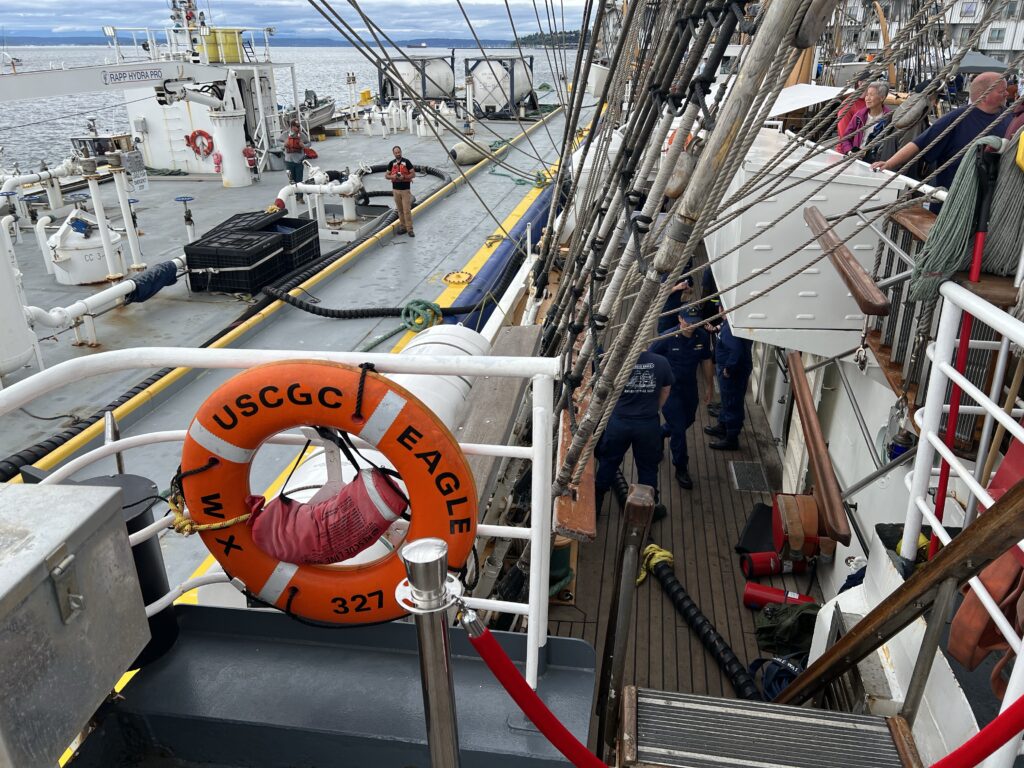
EAGLE BY THE NUMBERS
- Length – 295 feet (90 meters), 233 feet (71.02 meters) at waterline
- Beam, greatest – 39.1 feet (11.9 meters)
- Freeboard – 9.1 feet (2.8 meters)
- Draft, fully loaded – 17 feet (5.18 meters)
- Displacement – 1,816 tons (1647.4 metric tons)
- Ballast (lead) – 344 tons (312.07 metric tons)
- Fuel oil – 24,215 gallons (91,663.7 liters)
- Anchors – 3,500 lbs. (1587.6 kg) port, 3,850 lbs. (1,746.33 kg)
- starboard
- Rigging – 6 miles (9.7 km), standing & running
- Height of mainmast – 147.3 feet (44.9 meters) above the waterline
- Height of foremast – 147.3 feet (44.9 meters) above the waterline
- Height of mizzenmast – 132 feet (40.2 meters) above the waterline
- Fore and main yard – 78.8 feet (24 meters)
- Speed under power – 11 knots
- Speed under full sail – 17.5 knots
- Number of Sails – 23
- Sail area – 22,300 square feet (6797 square meters)
- Engine – 1,000 horsepower diesel Caterpillar D399 engine
- Generators – two-320 kilowatt Caterpillar 3406 generators
- Maximum capacity – 239 people

Accommodations and Living Arrangements
The Eagle can accommodate a maximum of 239 people, including crew and trainees78. The ship typically carries eight officers and 50 enlisted personnel, allowing for the training of up to 150 cadets or officer candidates on any voyage9.
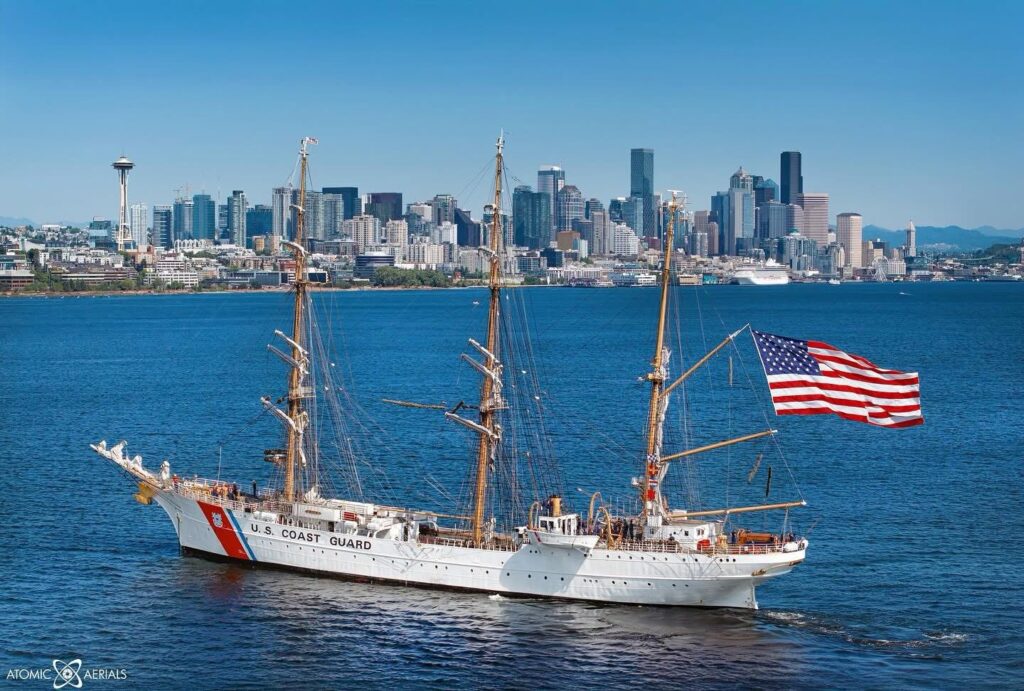
Berthing Arrangements
Berthing areas are filled with bunks layered three in height, providing about five inches of overhead clearance10.These “racks” are girded by metal rails and, while confining, provide reassuring security during rough seas10. The cramped quarters are intentional, teaching future officers about the realities of life at sea.
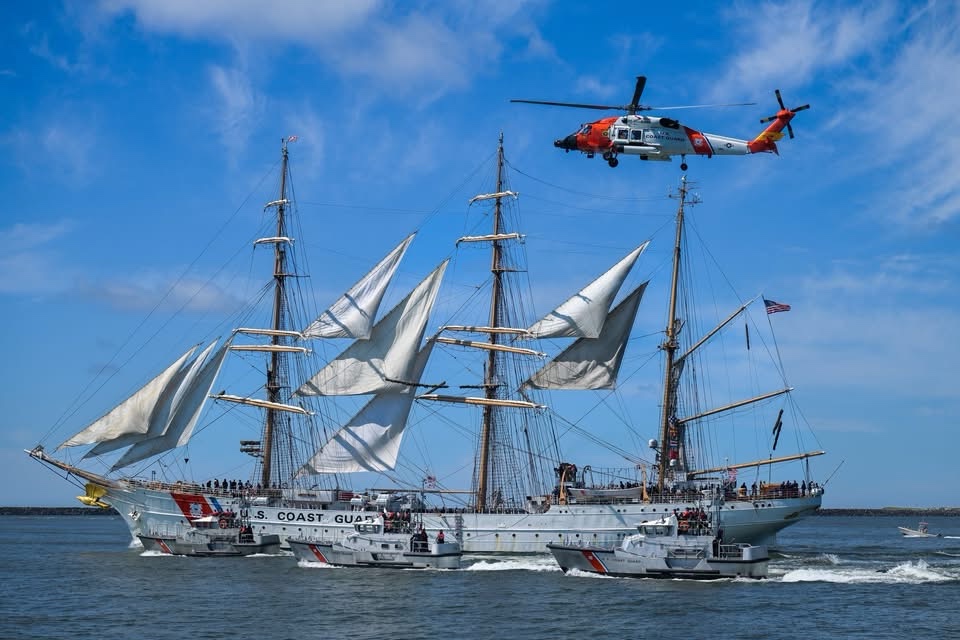
Dining Facilities
The ship features separate dining areas for different ranks and groups11:
- Crew members dine primarily on the messdeck
- Officers eat in the wardroom
- Family and guests of crew may dine in various locations depending on space and schedule11
Meal costs are structured as follows:
- Non-federal civilian guests: $19.50 per night regardless of meals consumed
- Reservists, Auxiliarists, and CG employees: $11.85 per night11
Medical Facilities
The Eagle maintains comprehensive medical capabilities with 20 well-stocked medical kit bags stationed throughout the ship8. The elegant wardroom doubles as a triage center if needed, and the ship includes painted arrows and medical-cross symbols in light-reflective red on interior walls to guide personnel during emergencies8.
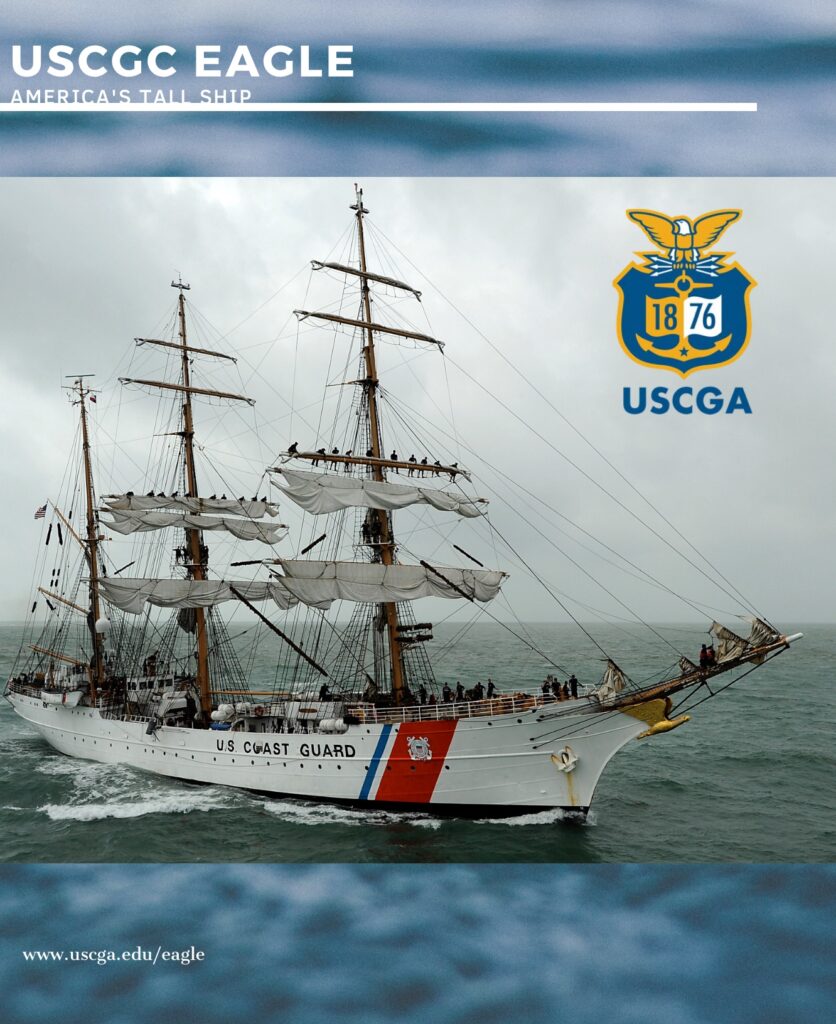
Command
The current captain of USCGC Eagle is Capt. Kristopher Ensley, who assumed command on June 27, 2025, succeeding Capt. Jessica Rozzi-Ochs1345. Capt. Ensley has been in command since that date.
“I am deeply honored and grateful for the opportunity to serve as the Eagle’s next commanding officer, building on the excellence and superior training already demonstrated by this remarkable crew,” Ensley said. “I look forward to growing and continuing our great legacy aboard America’s best and only active square-rigger.”
U.S. Coast Guard Cutter Eagle holds change of command ceremony
Ensley previously served as the operations officer aboard the Eagle with his latest assignment at the Coast Guard Office of Congressional Affairs.
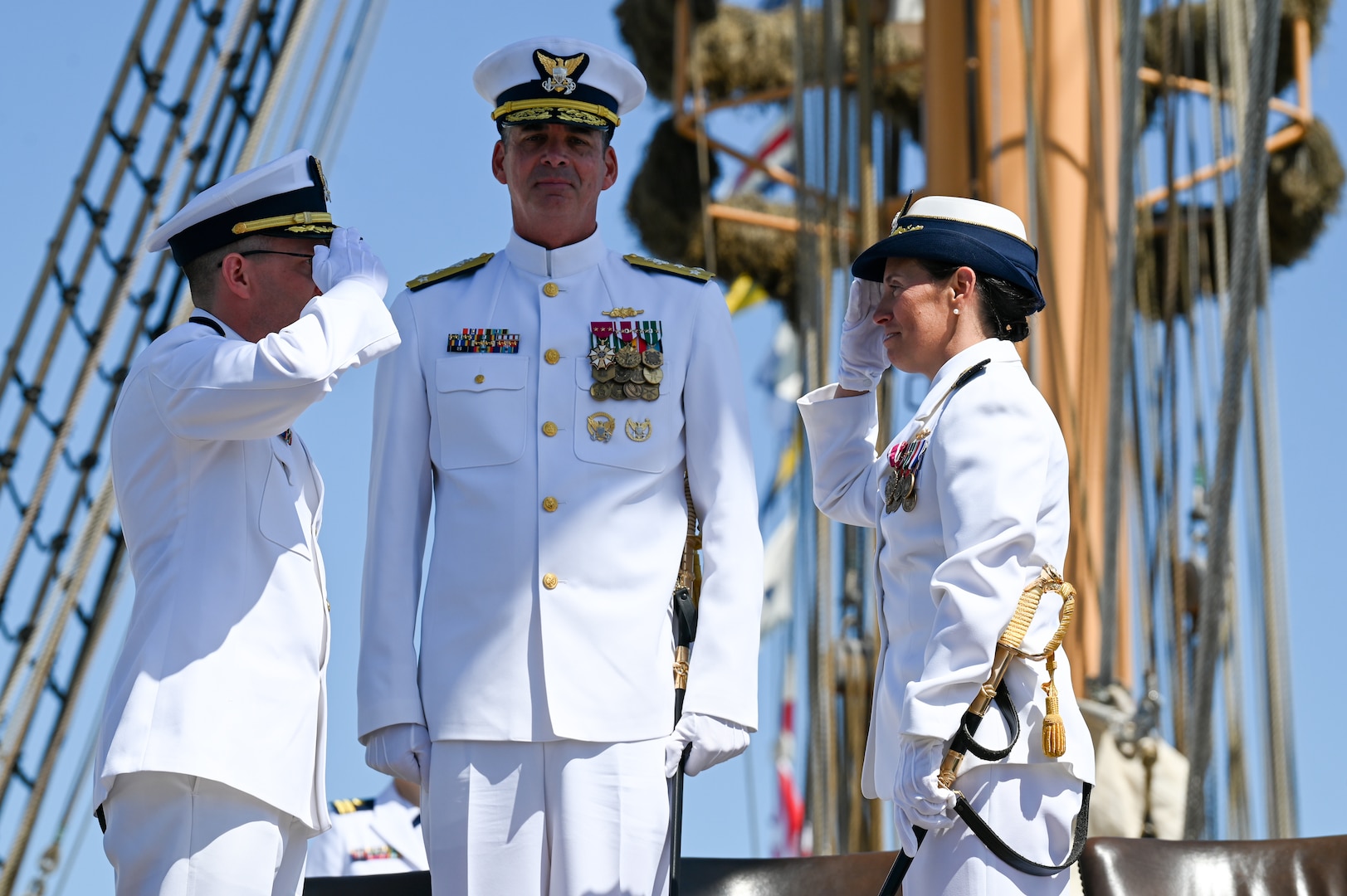
Capt. Jessica Rozzi-Ochs was Eagle’s first female commanding officer. She served from June 24, 2022, to June 27, 2025, making her the first woman to command the ship in its history23.
There have been no other women captains of Eagle before Capt. Rozzi-Ochs23.

Since 1946, there have been 31 commanding officers over 79 years of U.S. Coast Guard service, which equates to an average command duration of roughly 2.5 years per captain.
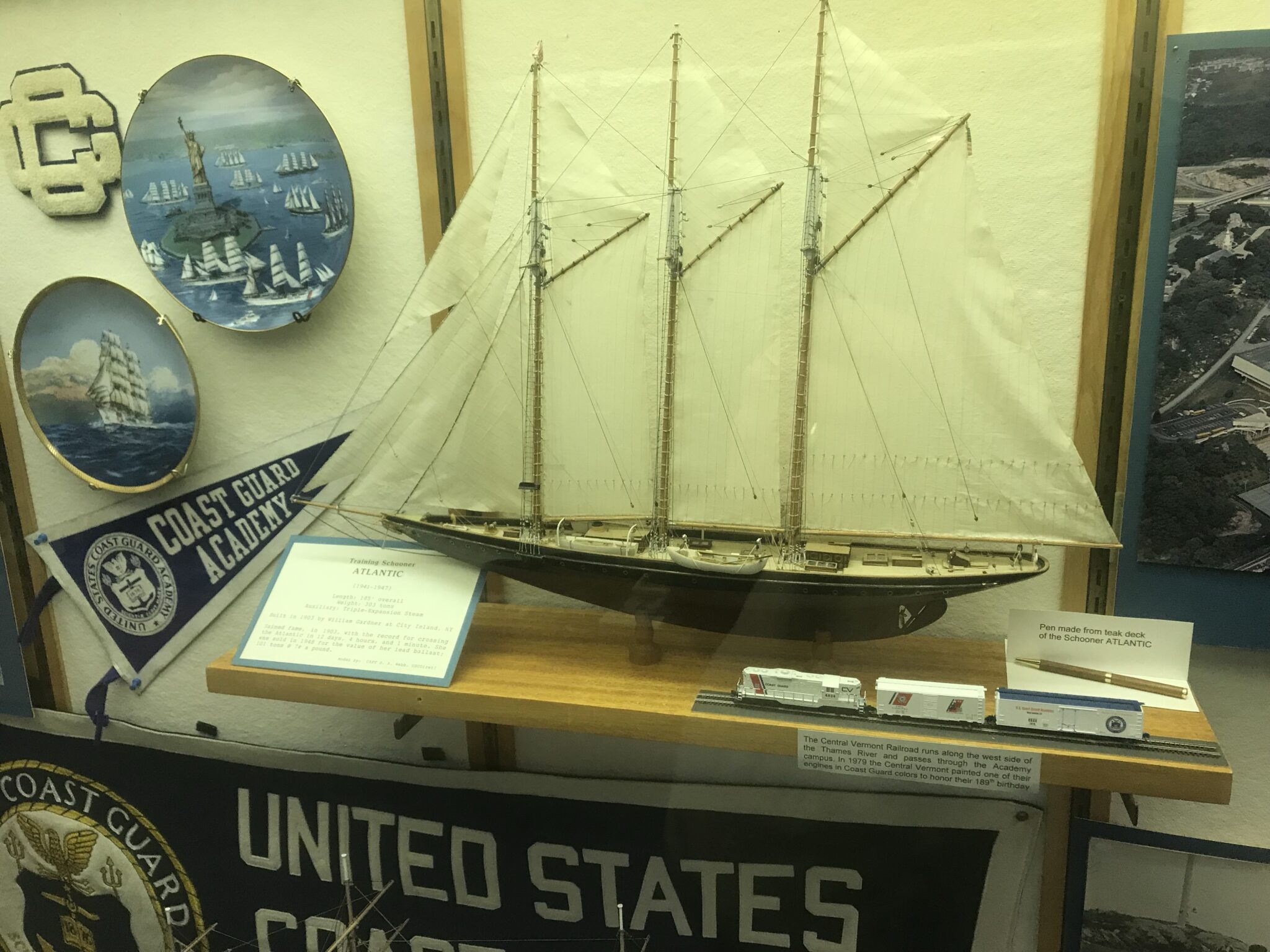
Post-command careers:
Many Eagle captains have gone on to distinguished Coast Guard careers, including several who achieved flag rank (admiral or vice admiral). Capt. Rozzi-Ochs is moving on to become the assistant superintendent at the Coast Guard Academy.
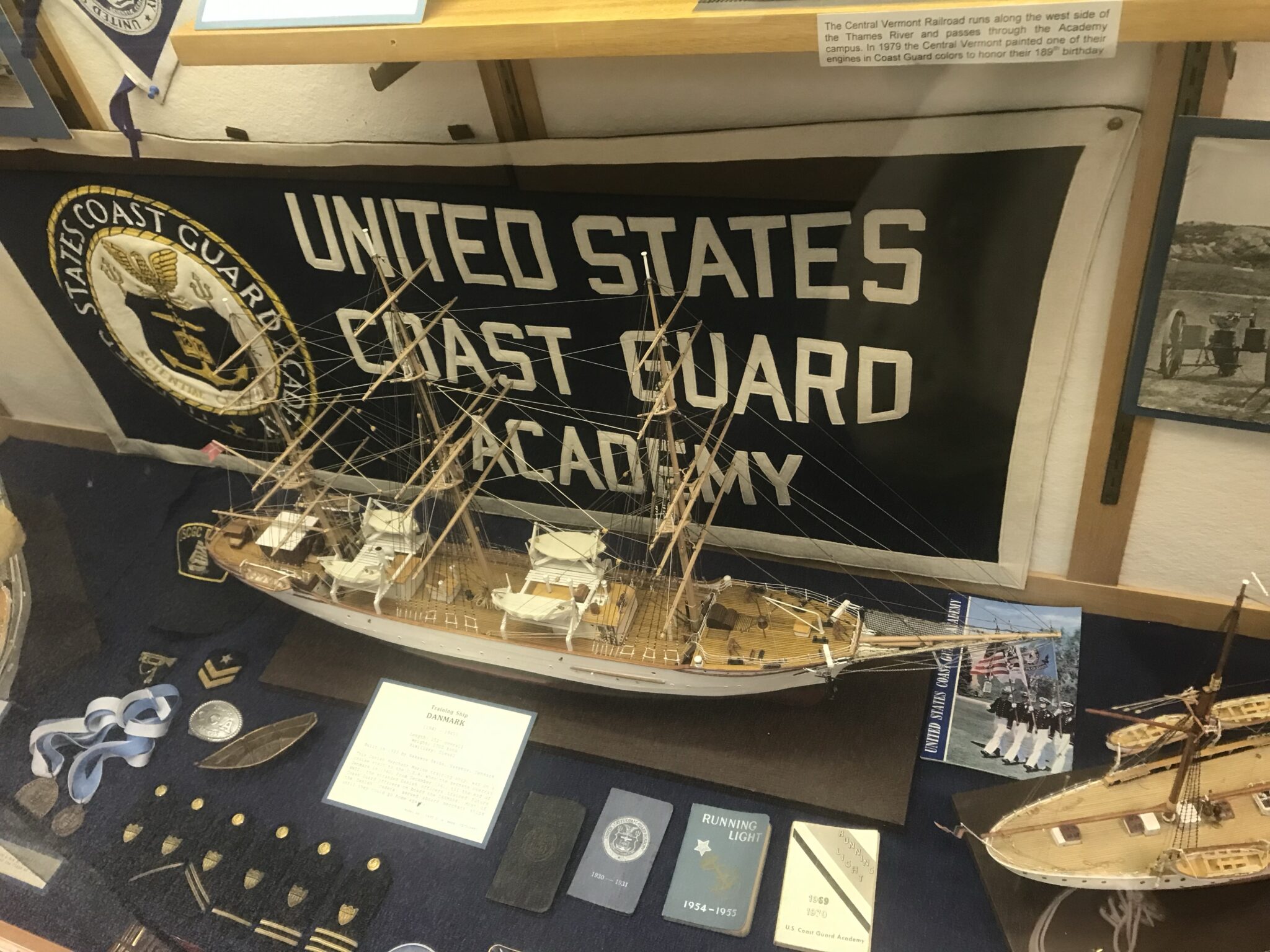
The U.S. Coast Guard Academy offers the following academic majors, all leading to a Bachelor of Science degree:
- Civil and Environmental Engineering
- Electrical Engineering
- Cyber Systems
- Interdisciplinary Engineering
- Mechanical Engineering
- Naval Architecture and Marine Engineering
- Operations Research and Data Analytics
- Marine and Environmental Sciences
- Management
- Government (Political Science)
All cadets complete a core curriculum grounded in the liberal arts, science, and engineering, providing a broad academic foundation to complement their chosen major215. The Academy’s programs are designed to prepare graduates for technical, operational, and leadership roles as commissioned officers in the Coast Guard.
Figurehead Damage on the 2025 West-Coast Cruise
USCGC Eagle lost a piece of her gold-painted fiberglass figurehead during the run up the Pacific coast to Seattle.
- What broke and when:
– On 28 June 2025, two days after clearing San Francisco, the barque encountered 35-kt north-westerlies and 12-15 ft seas off Cape Mendocino. A solid “green” sea came over the bowsprit and shaved off part of the starboard wing-tip and nicked the beak of the 2,000-lb eagle figurehead123.
– The crack was not superficial; the stainless armature and mounting brackets were unharmed4. - Was she under sail?
Yes. Eagle was motor-sailing under storm canvas (foresail, spanker and staysails) to hold course into the wind when the wave struck12. The damage therefore happened while the ship was, at least partly, under sail. - How it happened:
The new fiberglass figurehead (installed in 2021)5 is strong, but a direct blow from several tons of water at the bow’s waterline angle can fracture the thin outboard sections of the wings. This is the same failure mode that damaged earlier wooden and fiberglass figureheads in 1967 and 1972. - Repair plan:
Coast Guard Yard has already issued a work order (Solicitation 52000QR240002796) directing the original sculptor, Shane Kinman, to remove, repair and re-gild the figurehead during Eagle’s scheduled post-deployment availability at Curtis Bay from October to December 202546. Until then the ship’s carpenters have faired the edge with epoxy and spot-painted it so visitors in Seattle will see only a small flat on the wing. - An omen?
Sailors once viewed a damaged figurehead as bad luck, but Eagle has broken or replaced figureheads at least four times without subsequent mishap54. The crew regard the 2025 chip as routine wear, not an ill omen.
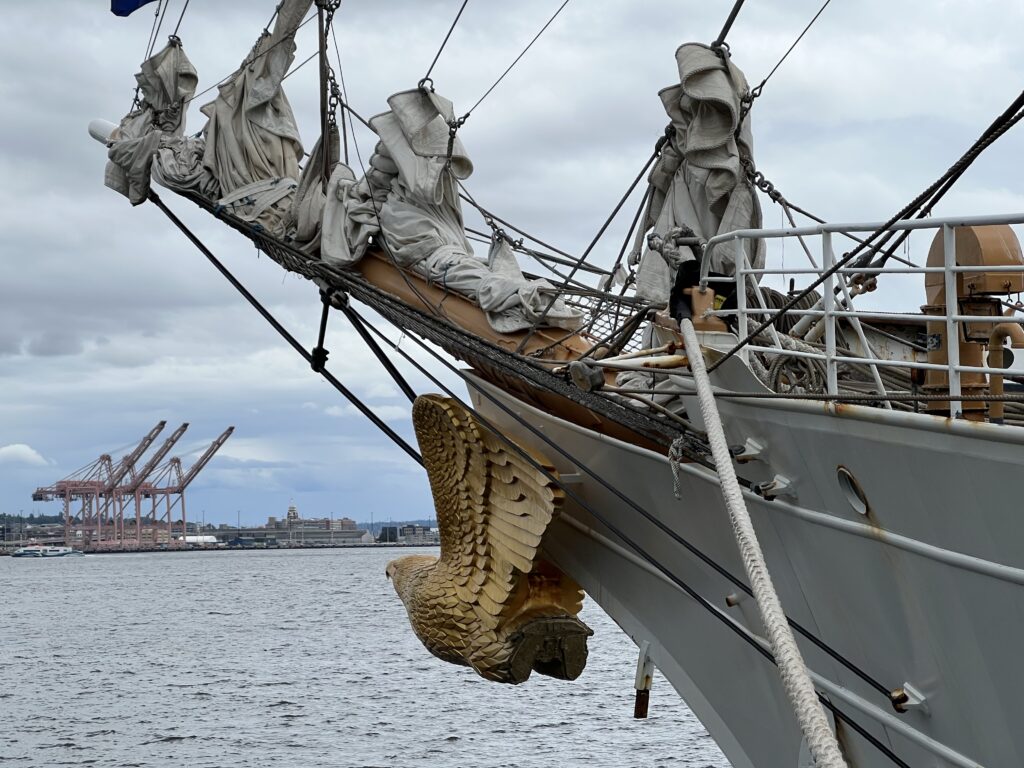
In short: a significant tail and wing loss did occur while Eagle was motor-sailing north. The fiberglass tail and wing section sunk into the sea and was lost. It was not the original and will be repaired this autumn. The crew are not losing sleep over maritime superstition; it has happened before and can be expected to happen again.
Propulsion Engine
- Current main engine: 1,200 horsepower (890 kW) MTU 8V 4000 diesel engine, installed during a 2018 refit123.
- Previous engines: Originally, Eagle was powered by a Burmeister & Wain diesel. In 1980, this was replaced by a 1,000 hp Caterpillar D399 V16 diesel engine, which was itself replaced by the current MTU engine14.
- Speed under power: Up to 11 knots14.
- Propeller: The propeller shaft can be de-clutched to reduce drag while under sail1.


The 2018 refit of USCGC Eagle replaced her previous Caterpillar engine with a 1,200 horsepower MTU 8V 4000 diesel engine,
This brought several performance and maintenance improvements:
- Enhanced Reliability and Efficiency: The MTU 8V 4000 is a modern marine engine known for its exceptional fuel efficiency, reliability, and lower operating noise compared to older models. Its advanced technology ensures consistent performance and greater security at sea1.
- Reduced Noise and Vibration: The engine is mounted on a resilient system that absorbs vibration, resulting in quieter operation and improved comfort for crew and trainees1.
- Improved Automation and Monitoring: The refit included the MTU Callosum integrated ship automation system, allowing operators to monitor the propulsion plant, power supply, and other ship systems from a central location. This streamlines troubleshooting, enhances safety, and reduces crew workload21.
- Better Training Continuity: Many modern Coast Guard vessels use MTU engines, so cadets training on Eagle now gain experience directly transferable to the broader fleet, improving operational readiness2.
- Easier Maintenance: The new engine and automation system simplify diagnostics and routine servicing, reducing downtime and the complexity of repairs21.

The 2018 refit of USCGC Eagle, which installed a modern MTU 8V 4000 diesel engine, improves fuel efficiency during long voyages in several ways:
- Advanced Engine Technology: The MTU 8V 4000 uses state-of-the-art fuel injection and combustion management, delivering more power per gallon of fuel compared to older engines. This means Eagle can travel farther on the same amount of fuel.
- Reduced Drag: The refit included the ability to de-clutch the propeller shaft when under sail, minimizing drag from the propeller and allowing the ship to maximize wind power and minimize engine use, directly reducing fuel consumption.
- Automated Monitoring: The new engine is integrated with a ship automation system, allowing real-time monitoring and adjustments for optimal performance and fuel economy.
- Improved Maintenance: The modern engine requires less frequent and less intensive maintenance, ensuring it runs at peak efficiency for longer periods and reducing the risk of fuel-wasting malfunctions.
These upgrades collectively enable Eagle to operate more efficiently and economically on extended voyages, with lower fuel consumption and greater reliability than with her previous propulsion systems. While the search results do not provide Eagle-specific data, these improvements are consistent with best practices in marine fuel efficiency, such as engine optimization, drag reduction, and proactive maintenance235.
Electrical Generators
- Generators: Two 320 kW (430 hp) Caterpillar 3406 generators supply electrical power for shipboard systems24.
- These generators can be operated individually or in parallel, providing redundancy and flexibility14.
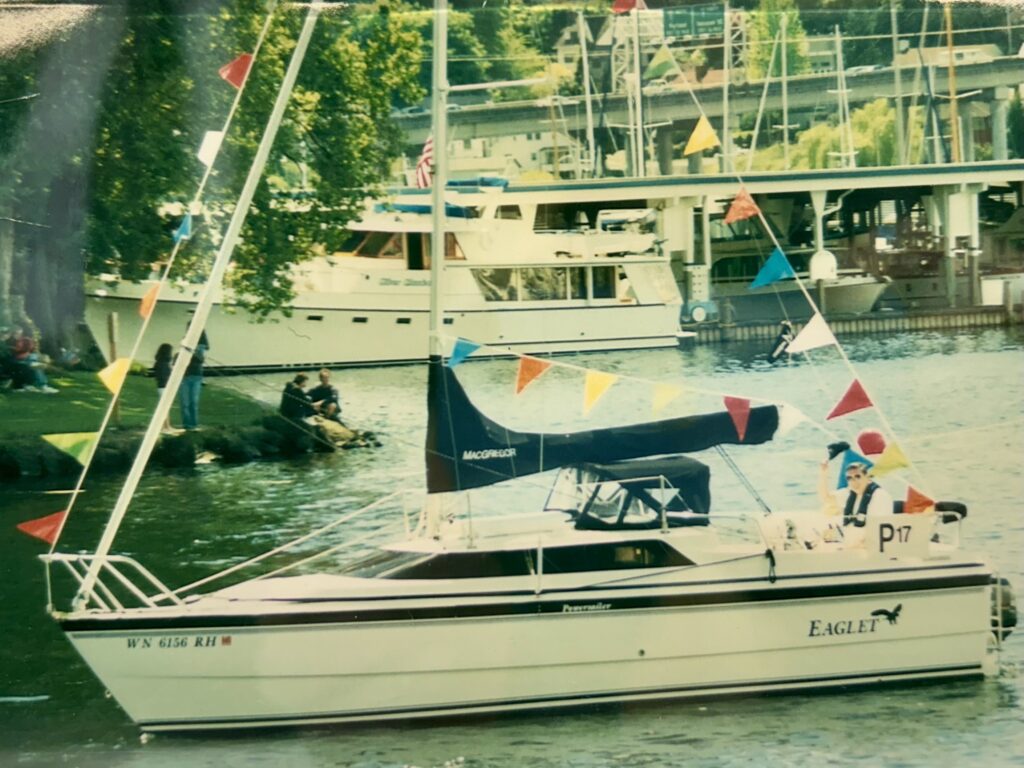
Small Boats
Small craft carried: Eagle carries several small boats, typically including rigid-hull inflatable boats (RHIBs) and/or traditional cutters or dinghies, used for ship-to-shore transport, man-overboard drills, and safety operations.
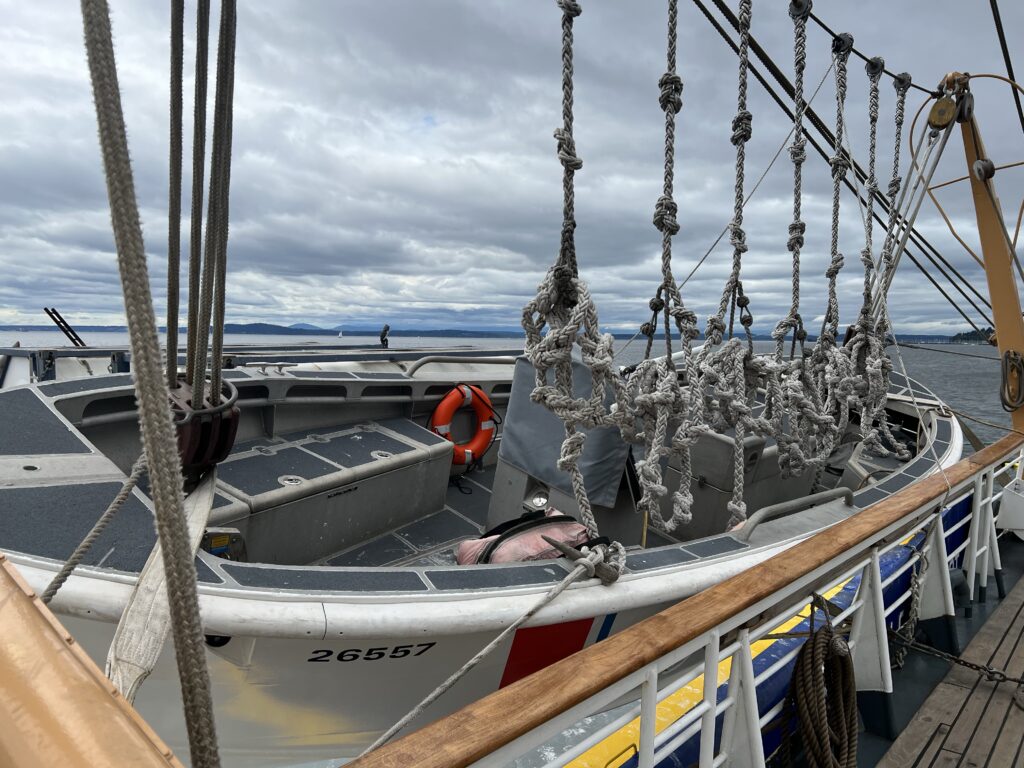
While the specific number and type of small boats are not detailed in the provided search results, it is standard for Eagle to carry at least one or two small boats for operational needs, as is customary on Coast Guard vessels of her class1.
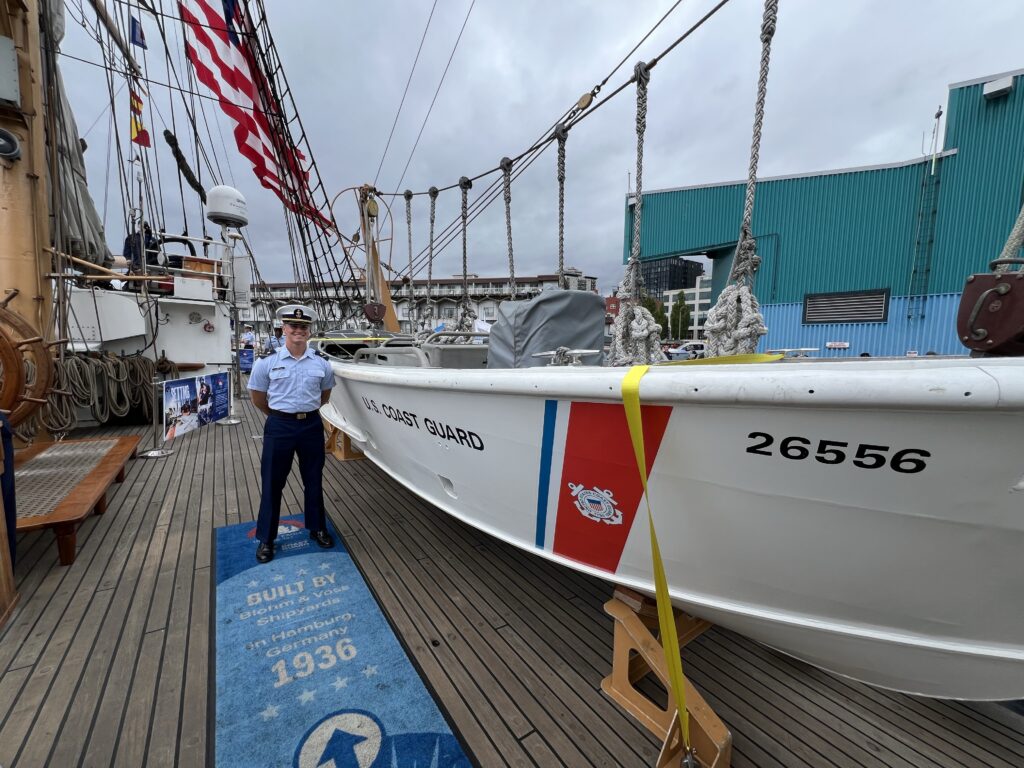

USCGC Eagle is equipped with modern auxiliary propulsion and electrical systems, as well as small boats for operational flexibility.
In summary:
- Eagle is powered by a 1,200 hp MTU 8V 4000 diesel engine and two 320 kW Caterpillar 3406 generators124.
- She carries small boats such as RHIBs or cutters for utility and safety purposes1.
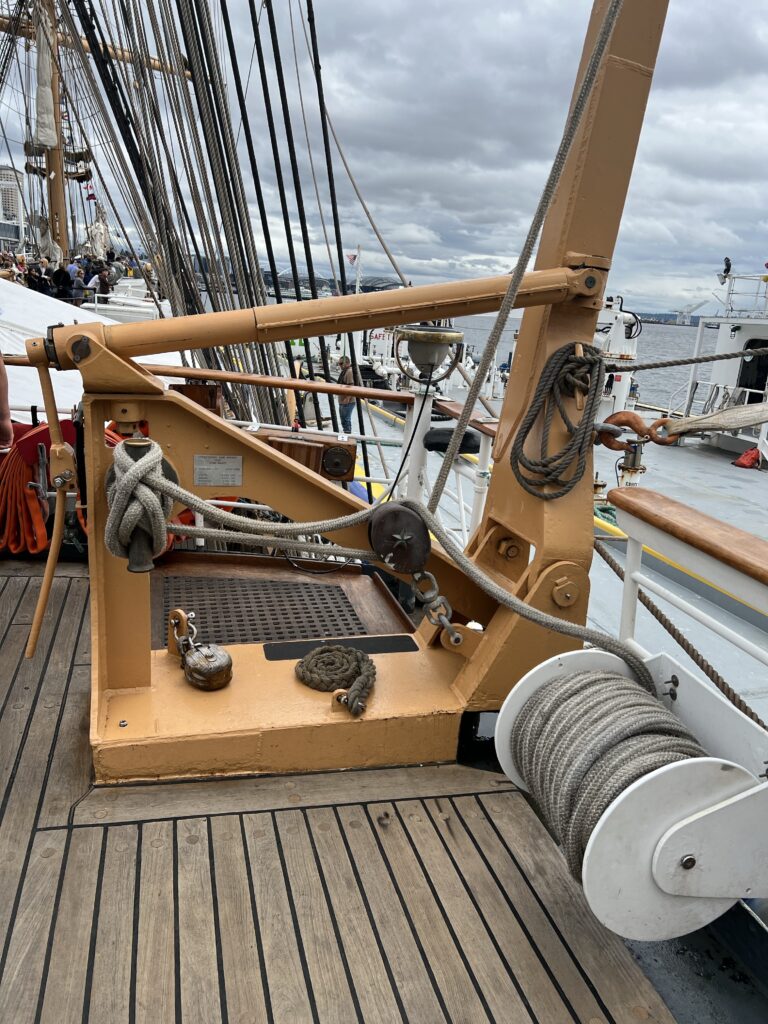
Seattle Visit Schedule and Tour Information
The Eagle will make a historic visit to Seattle on Wednesday July 9 2025 – her first appearance on the West Coast since 20081213. This visit is part of a comprehensive 14-week West Coast tour that includes stops from San Diego to Seattle.
Tour Details for Seattle
The Eagle will offer free public tours during her Seattle visit1214. Based on the pattern established at other ports during this tour:
- Tours are completely free of charge151614
- No tickets or reservations are required151614
- Visitors must present government-issued photo ID (regular driver’s license is sufficient – Real ID is not required)16
- All visitors must pass through airport-style security screening1517
- Closed-toe shoes are mandatory1817
To tour the Eagle in Seattle:
- No advance tickets needed – simply arrive during published tour hours1516
- Bring valid government-issued photo identification1516
- Prepare for security screening similar to airport procedures1517
- Wear closed-toe shoes (flat-heeled preferred for safety)1817
- Arrive early during peak times as tours operate on a first-come, first-served basis
Specific tour hours for Seattle have not yet been announced, but will be published closer to the arrival date1319. Tour announcements will be made through the “United States Coast Guard Barque EAGLE” Facebook page and Instagram @barqueeagle2018.






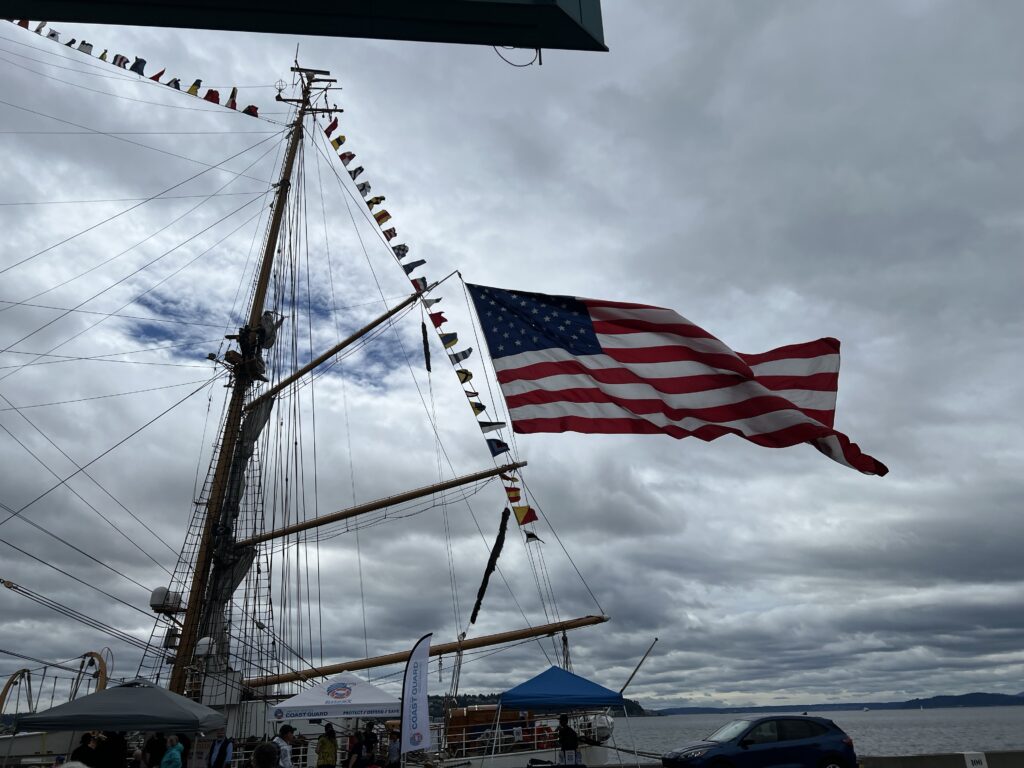
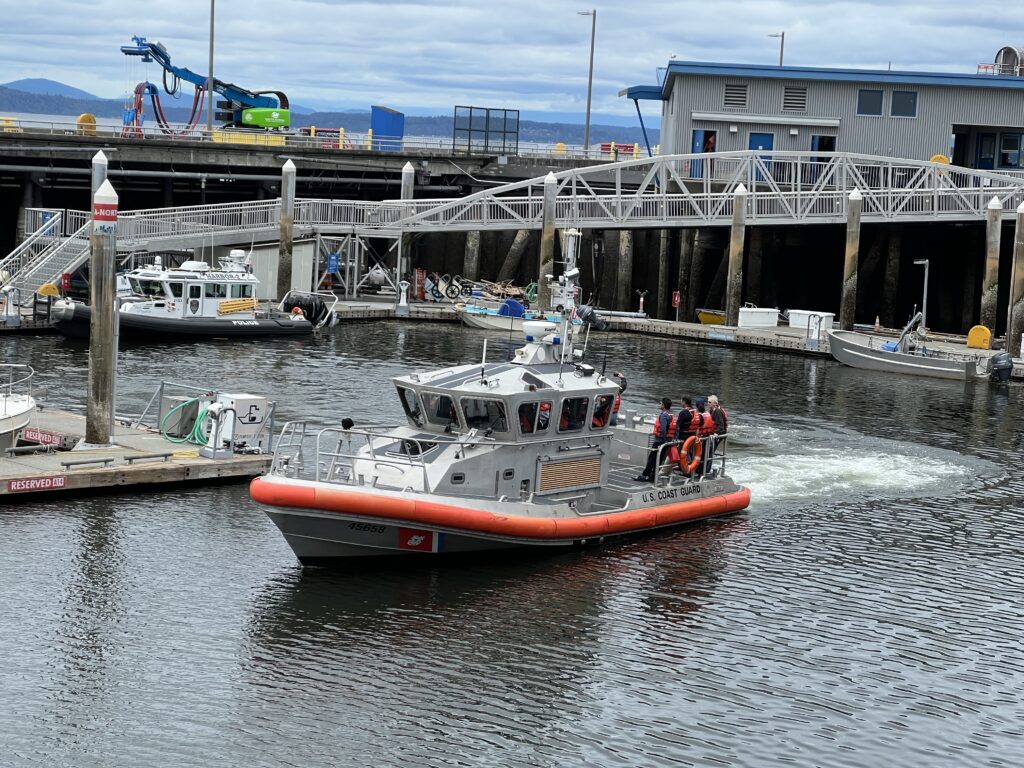
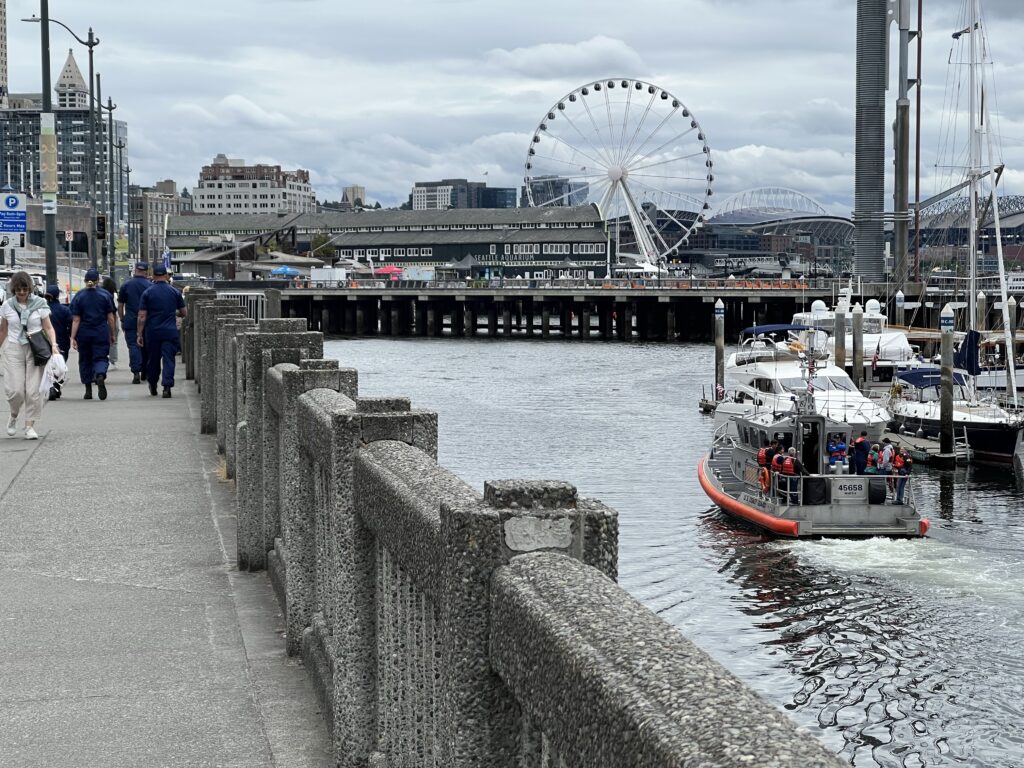
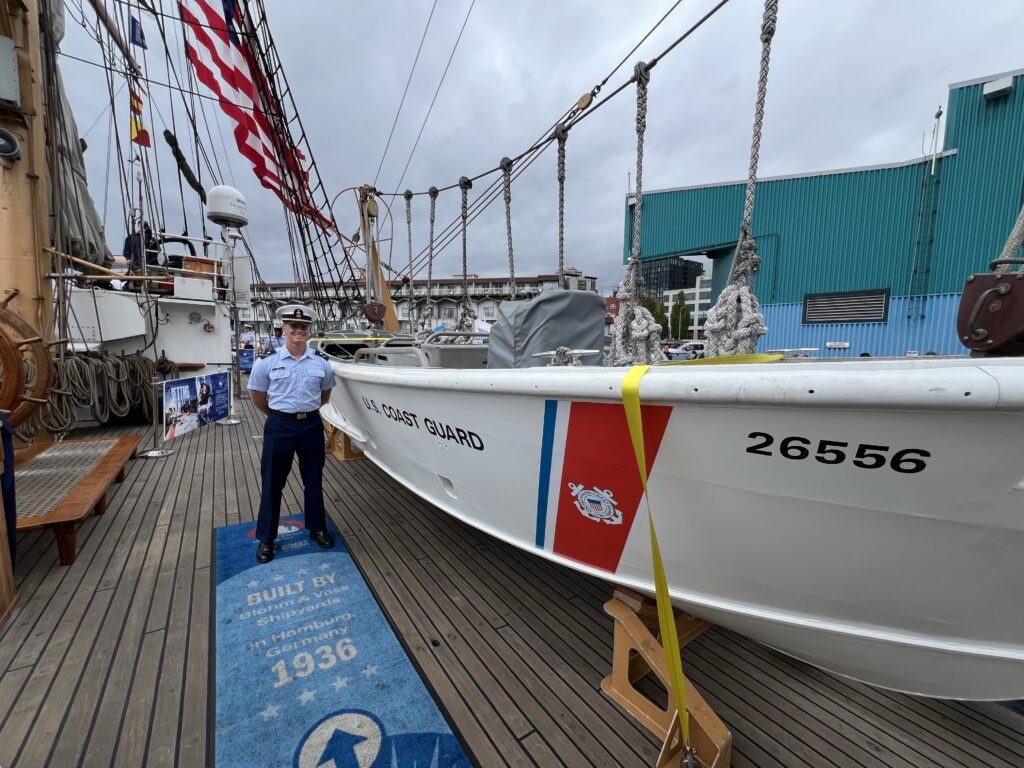
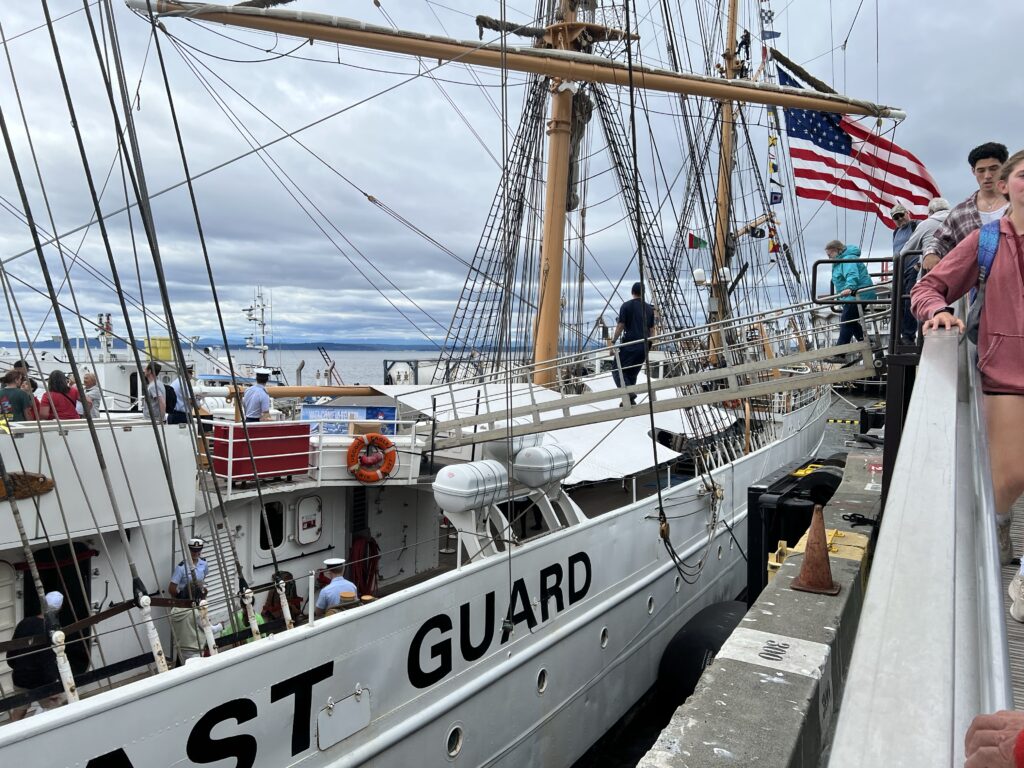
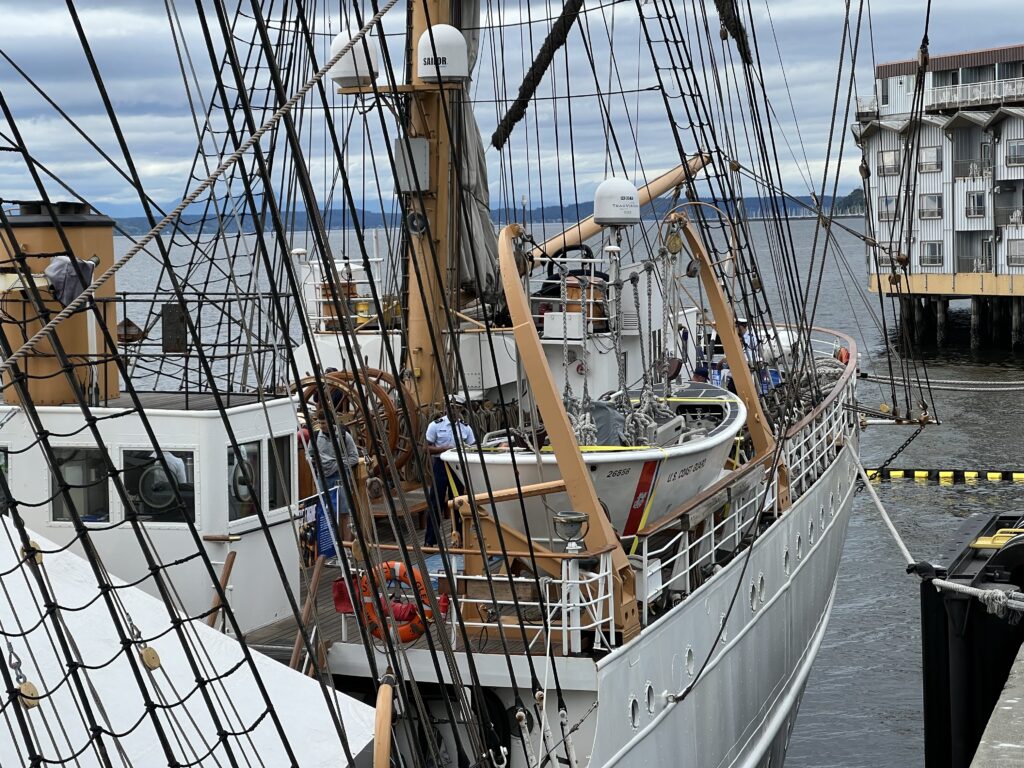


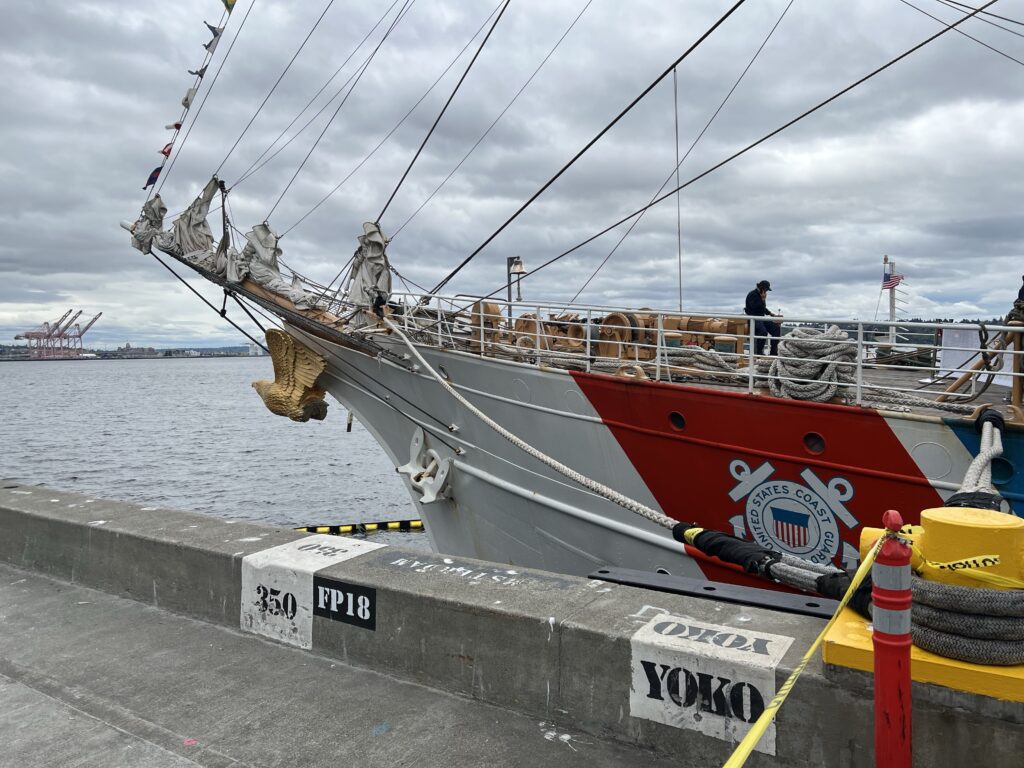
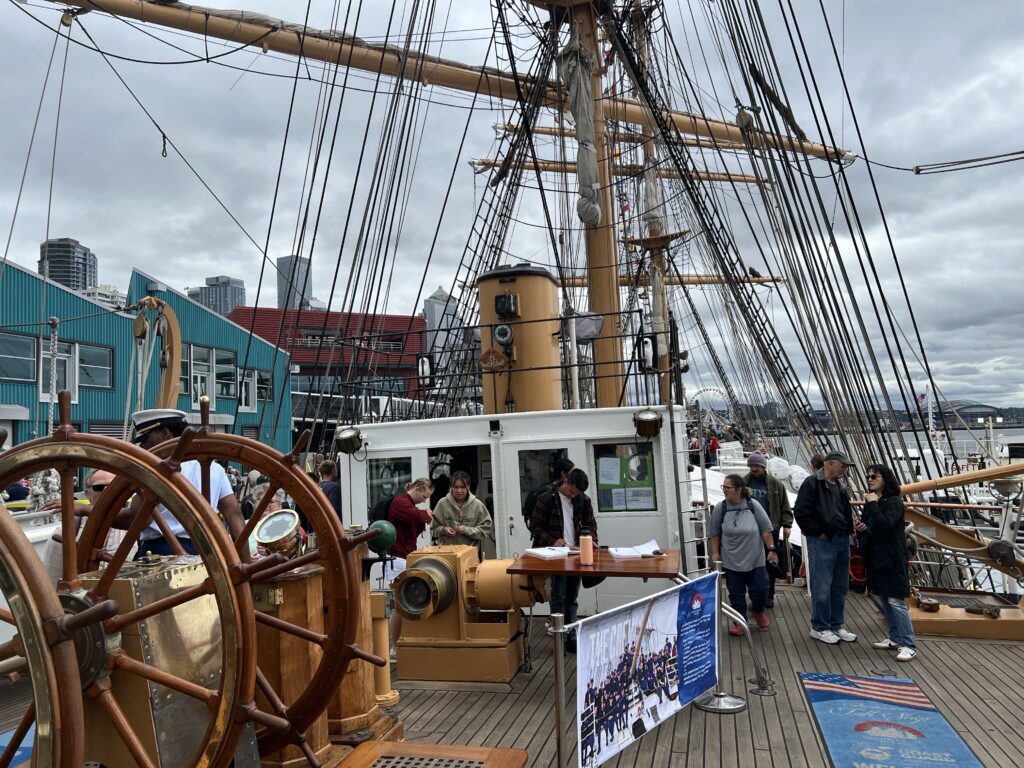



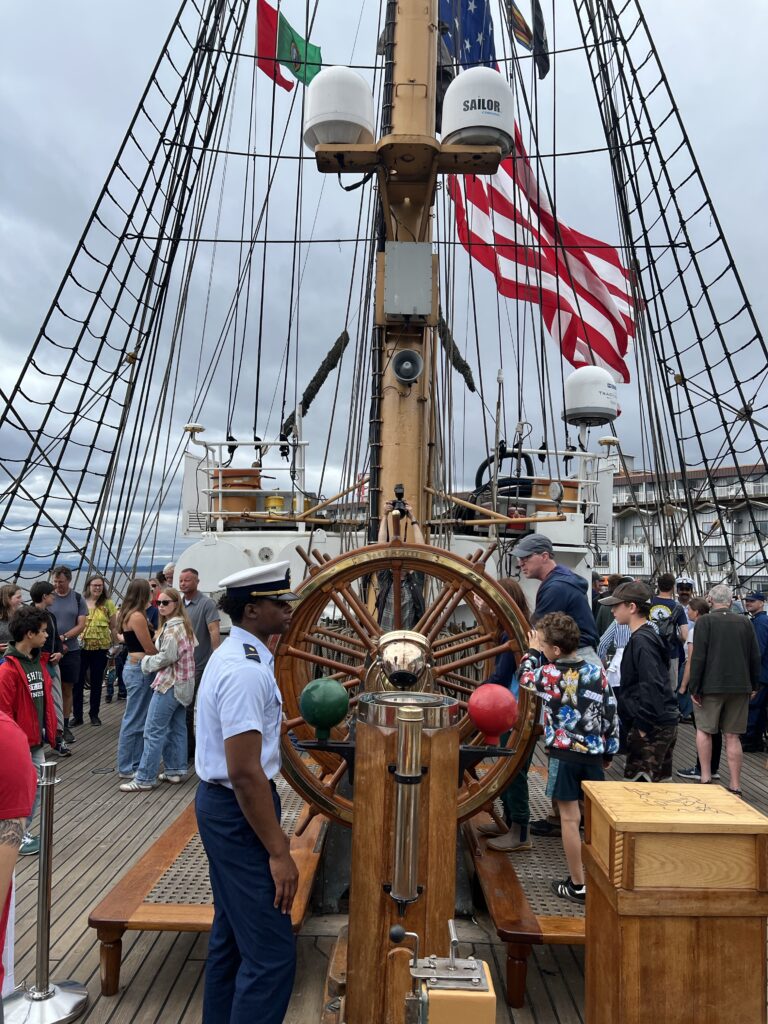

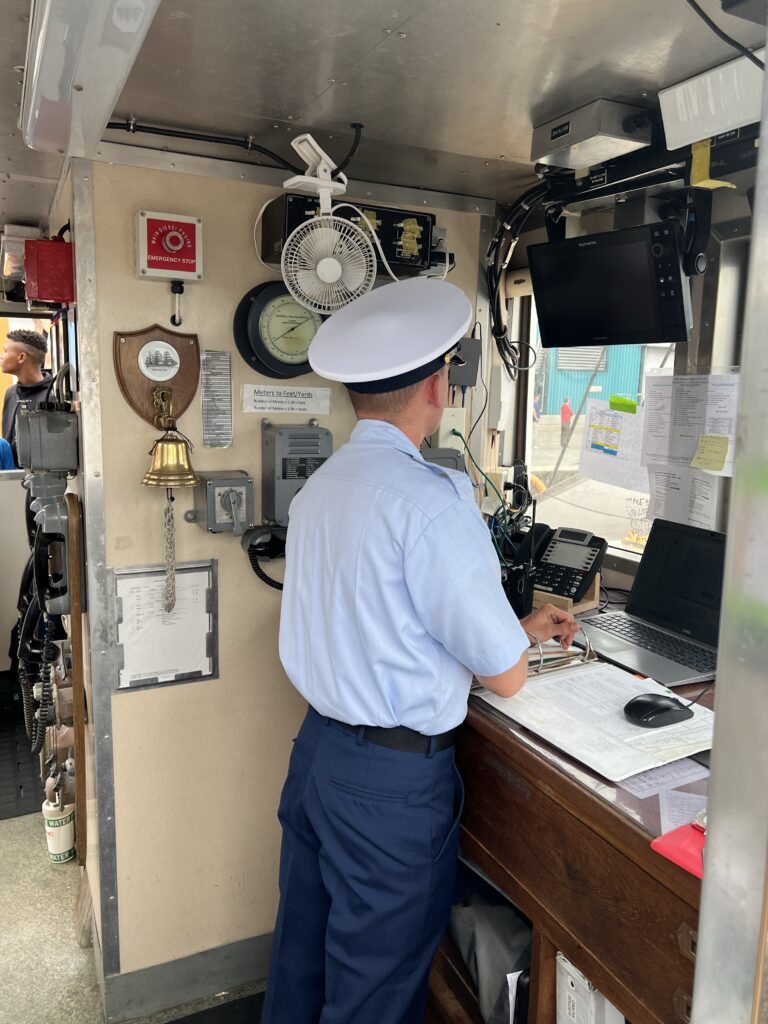
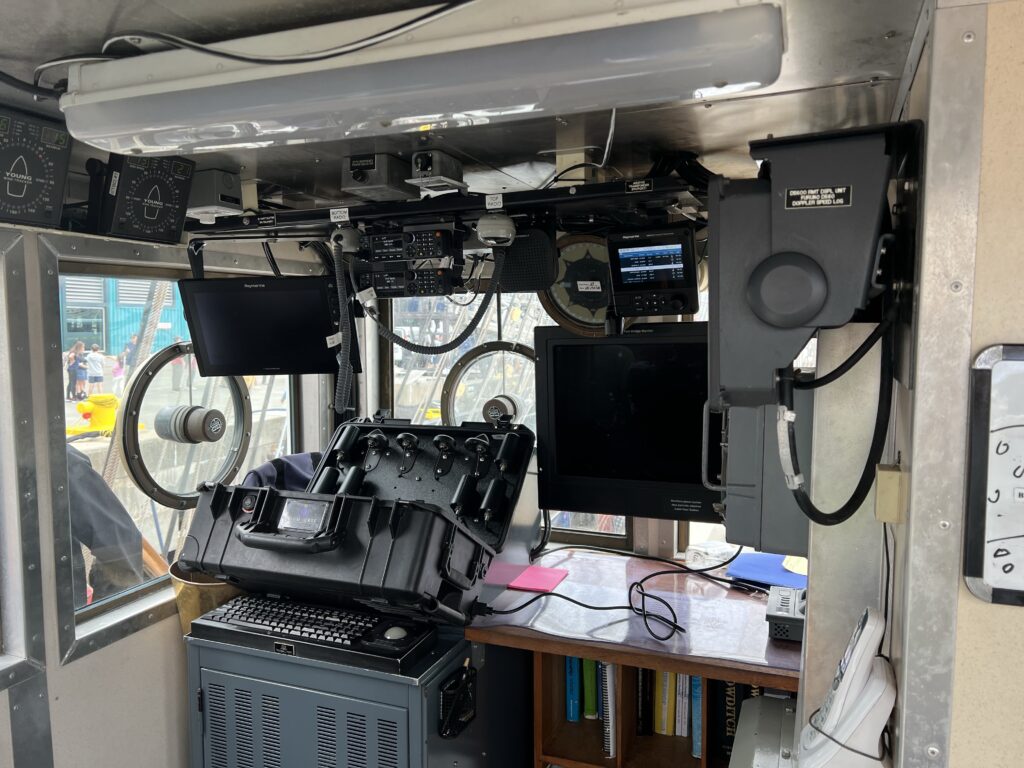
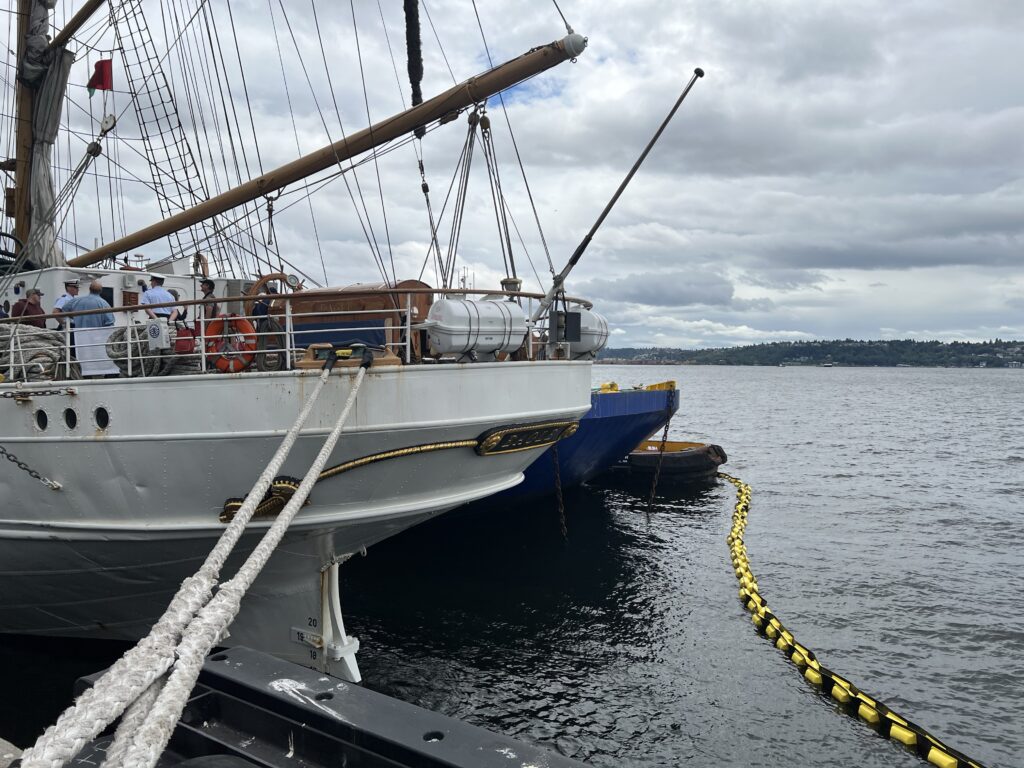
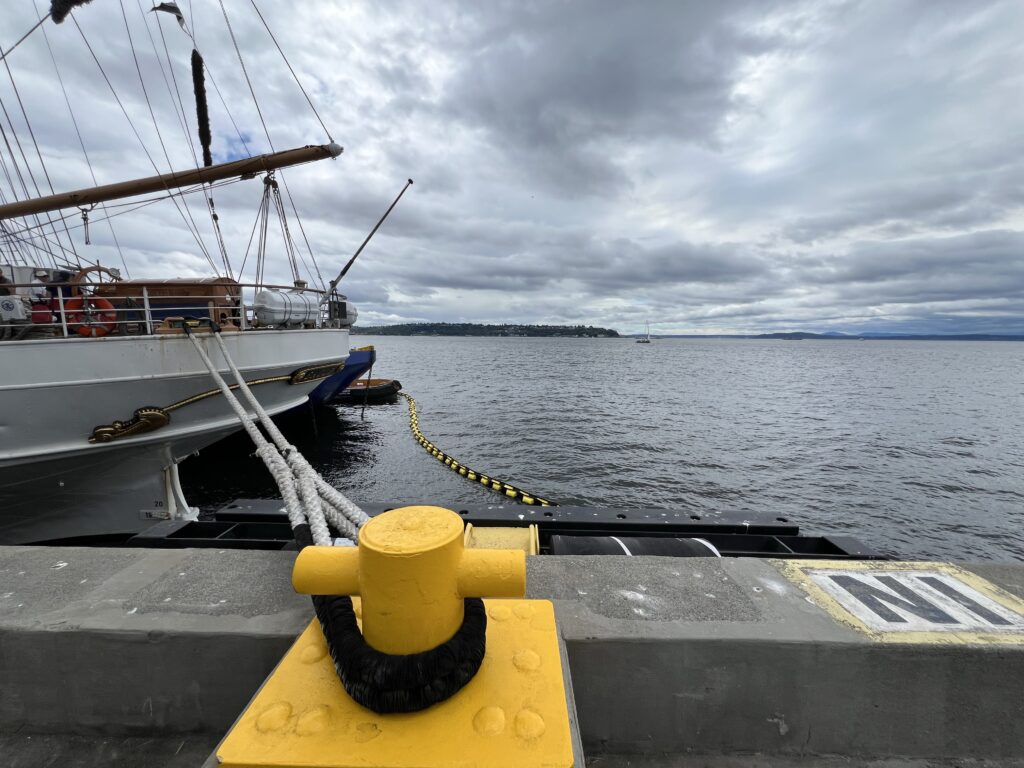
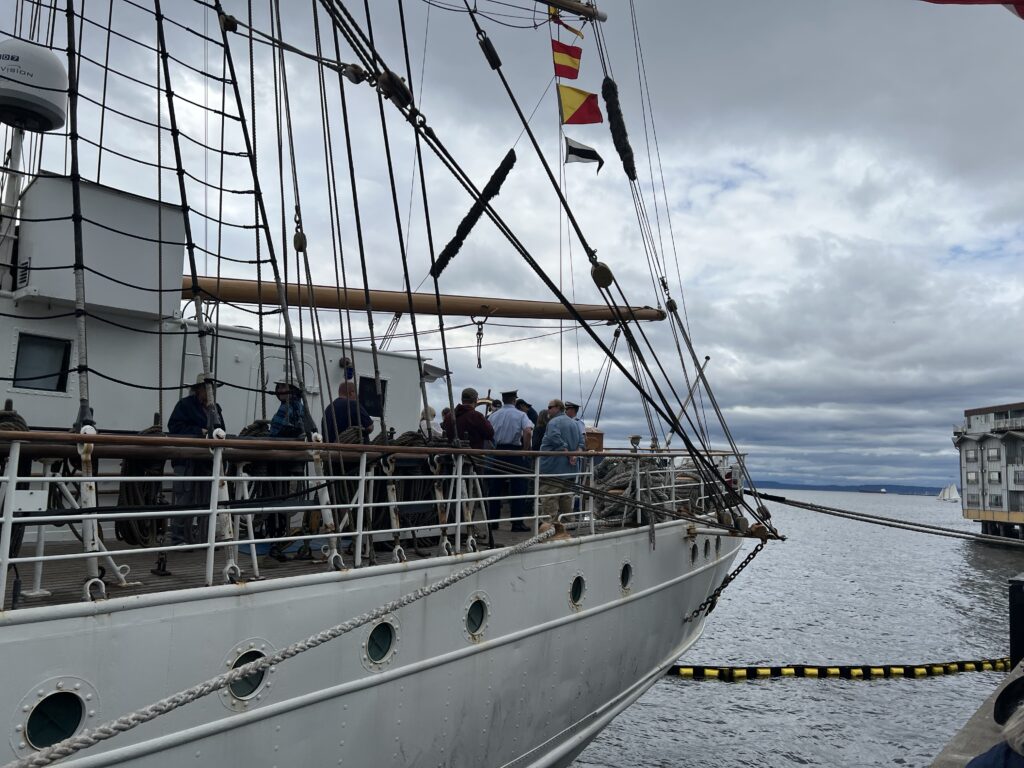

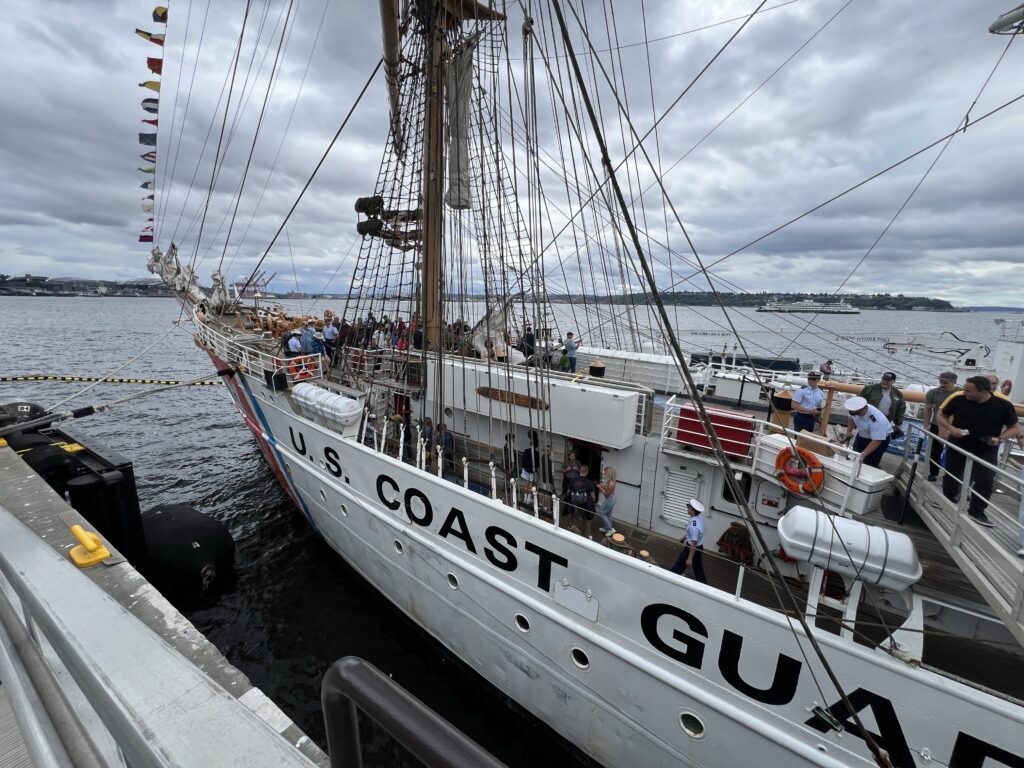
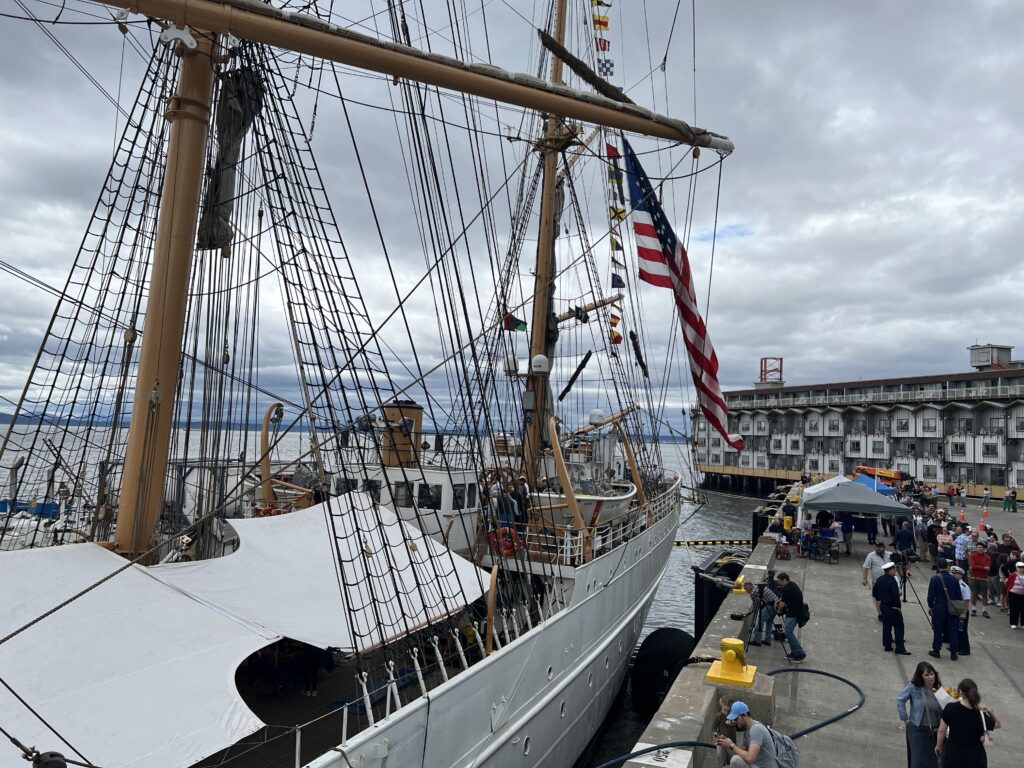




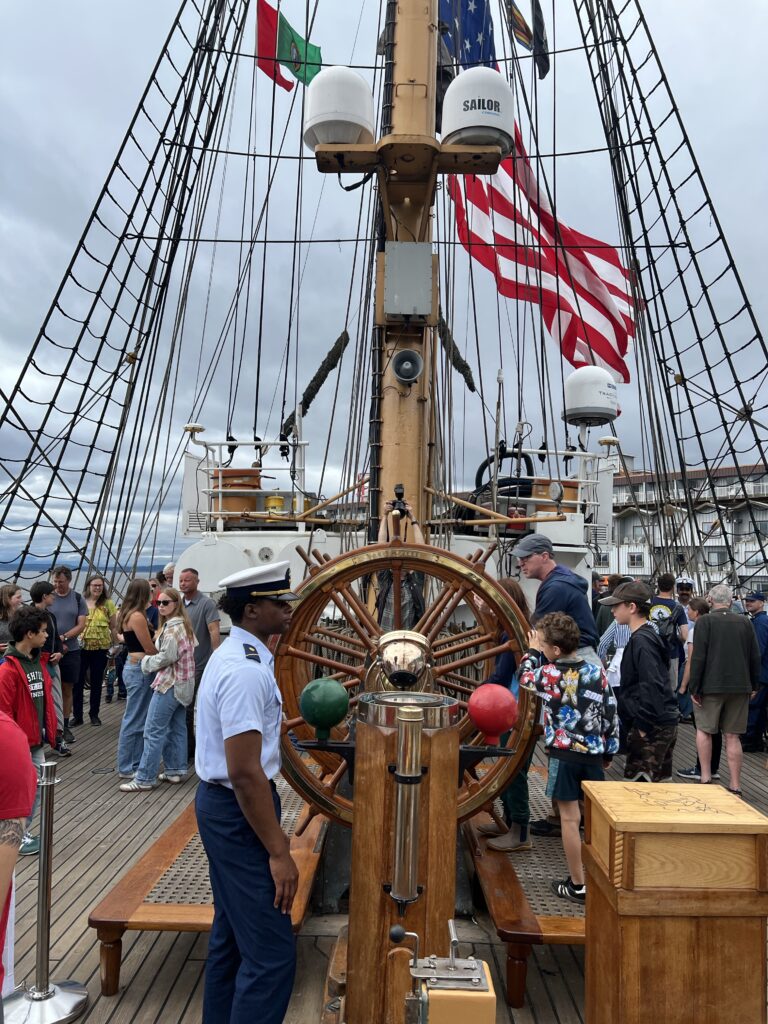

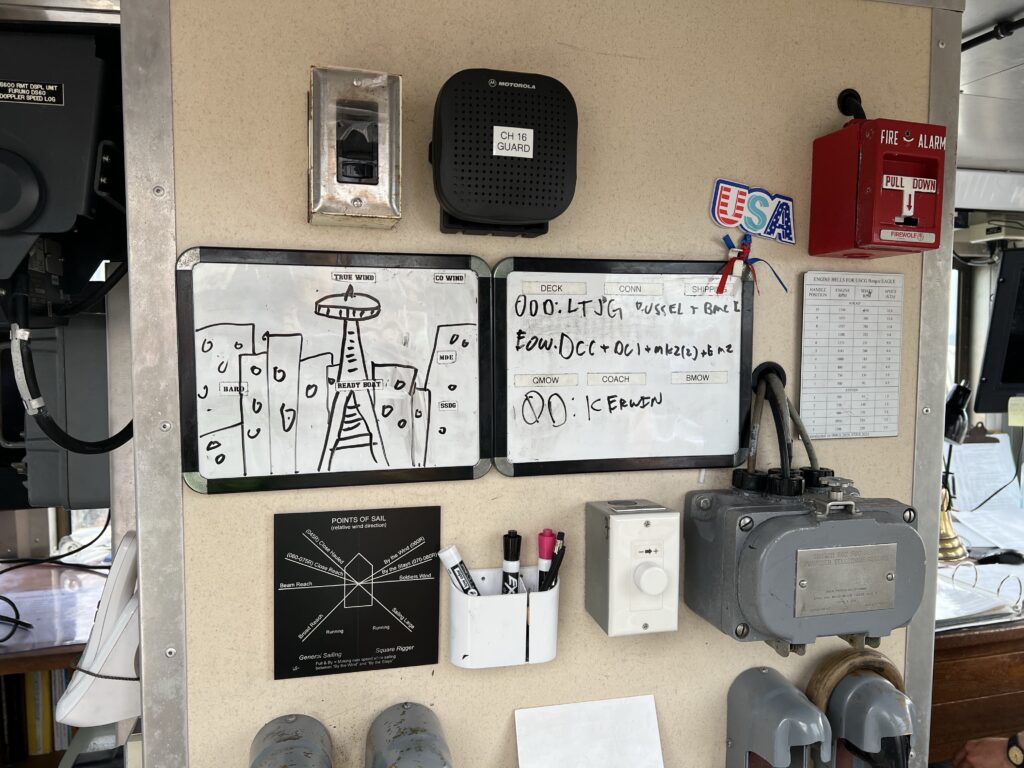
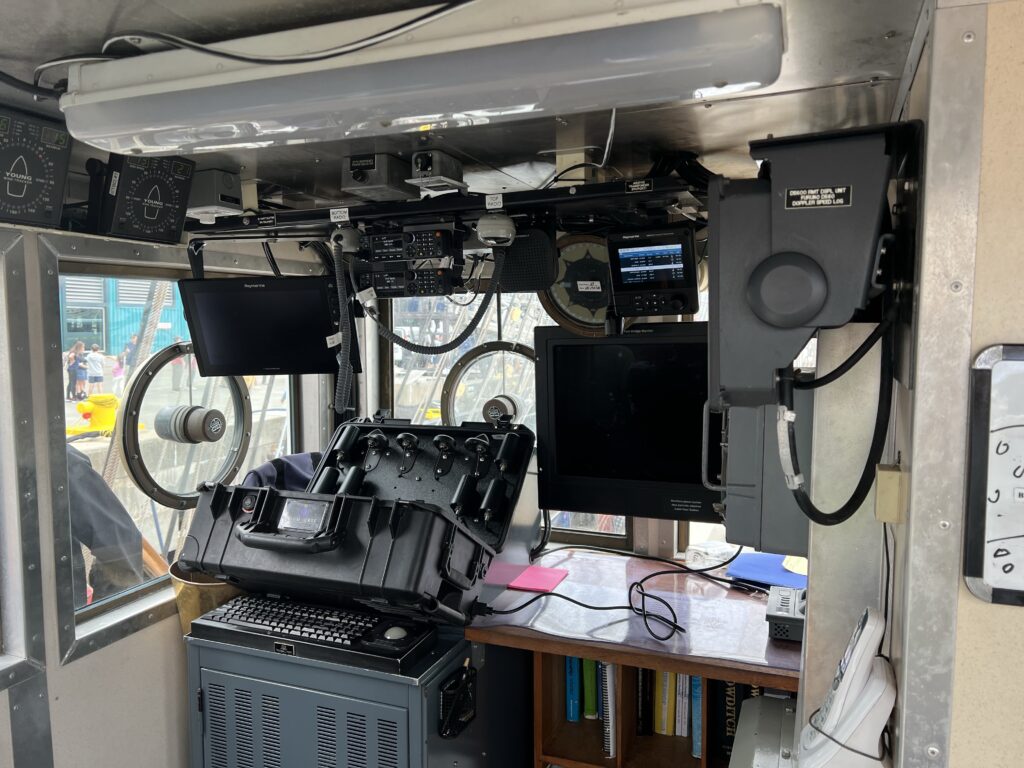
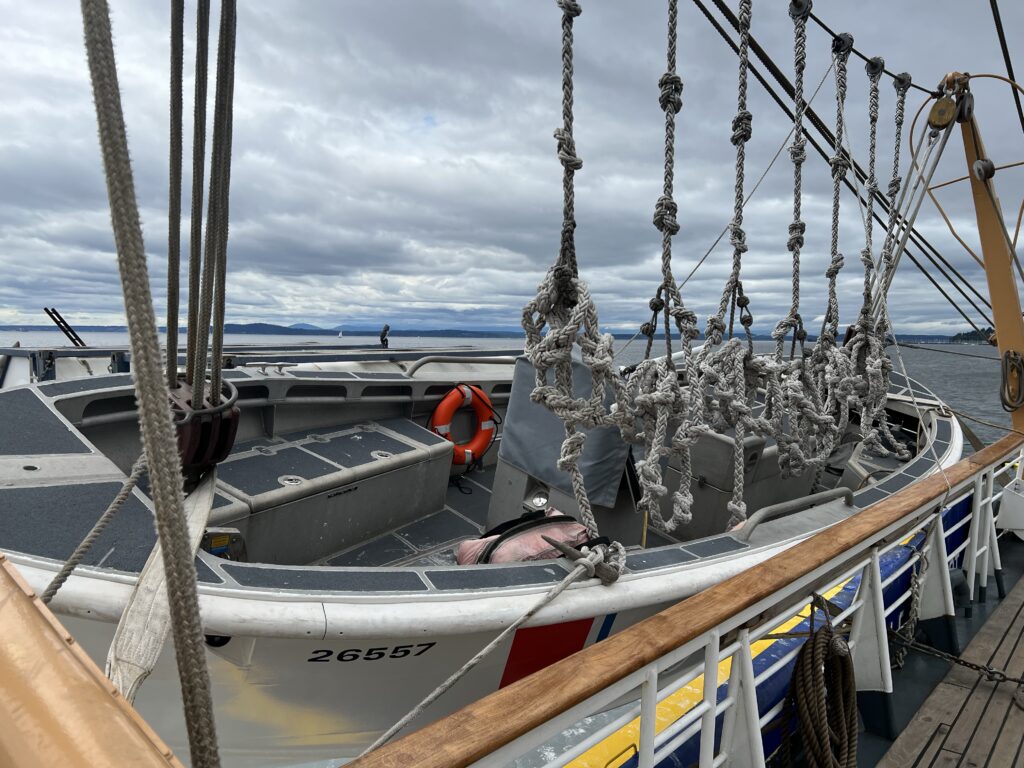
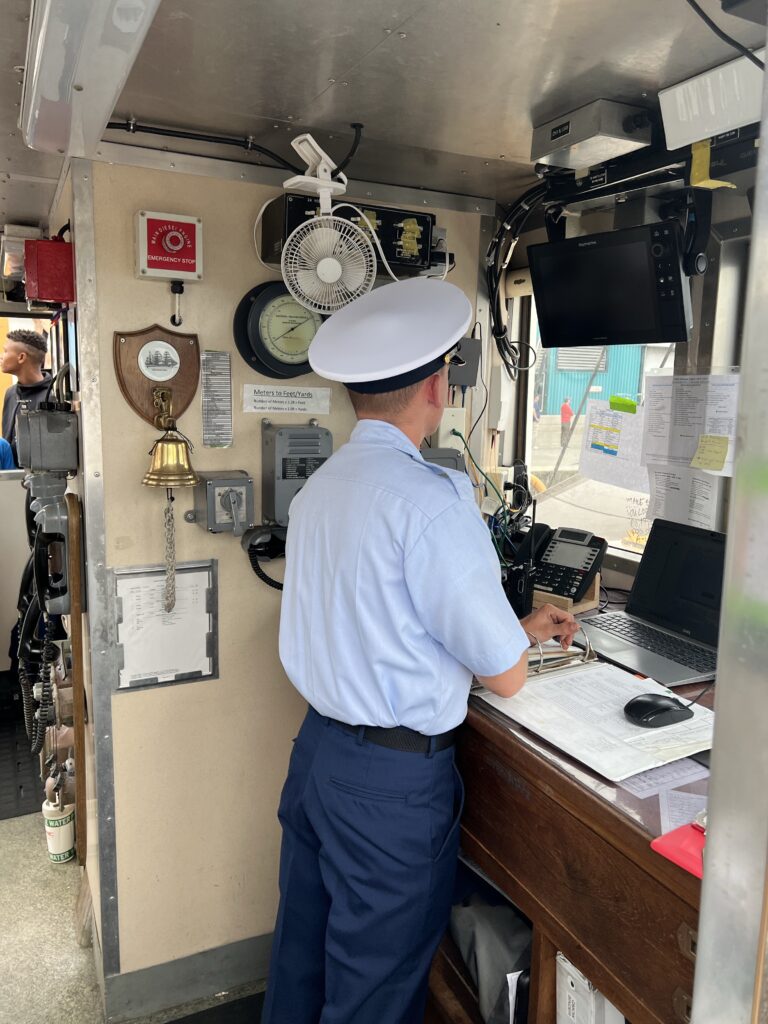
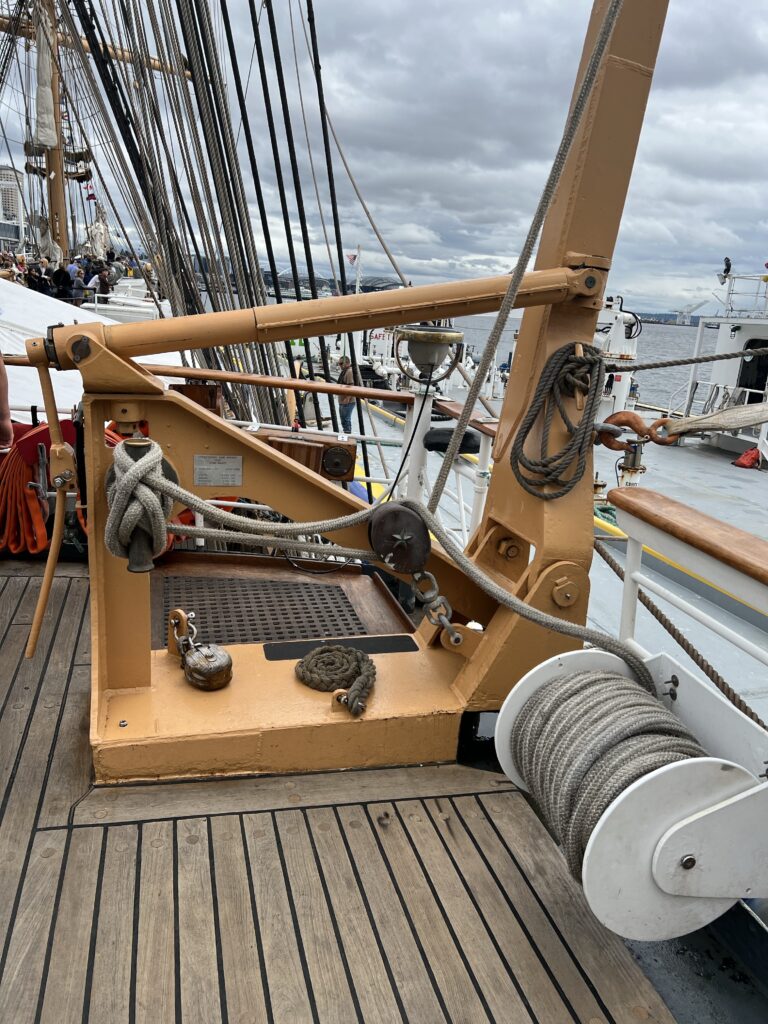

Additional West Coast Schedule
For those unable to visit in Seattle, the Eagle will also make stops at:
The Eagle’s mission combines training future Coast Guard officers with serving as a goodwill ambassador for the United States120. This rare West Coast appearance provides an extraordinary opportunity to experience maritime history aboard one of the world’s most beautiful tall ships.